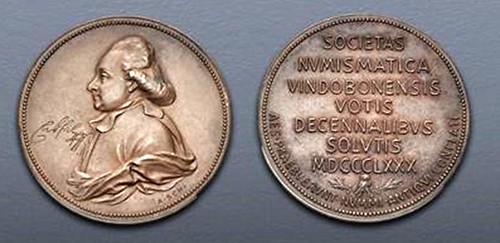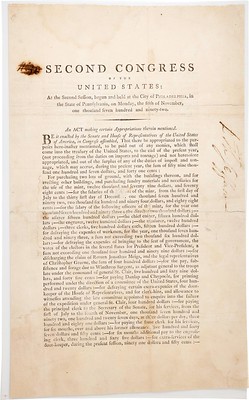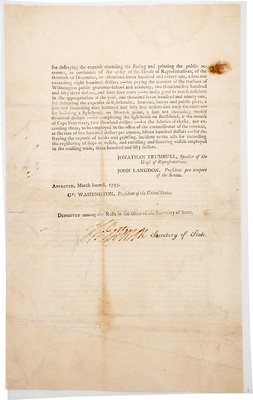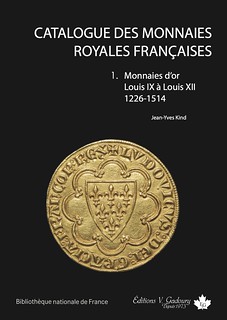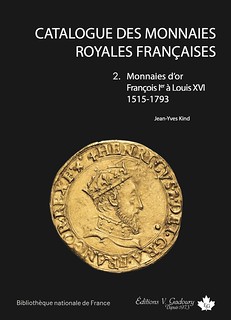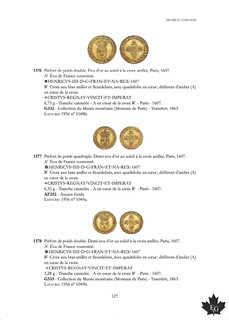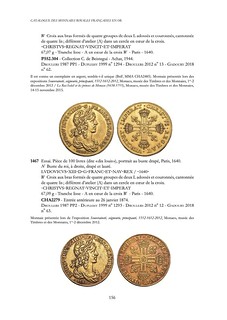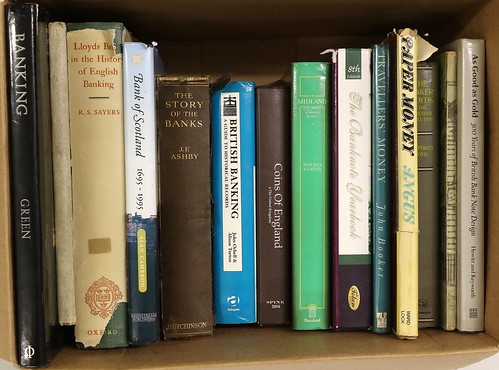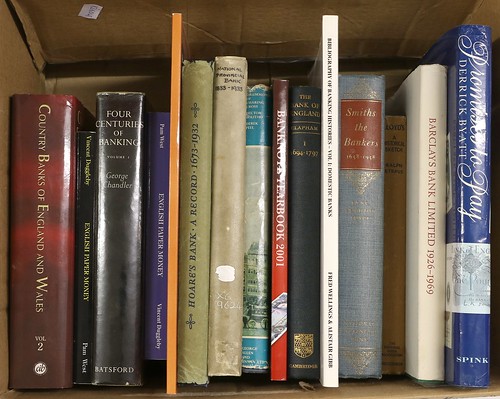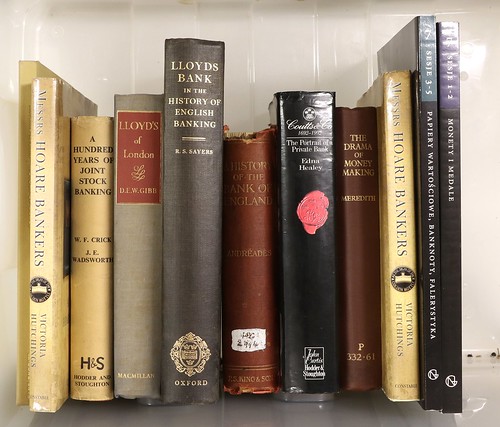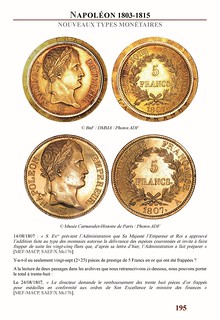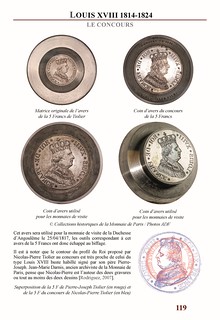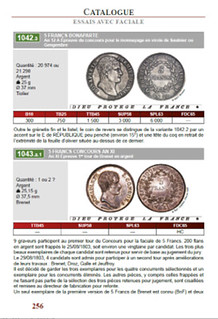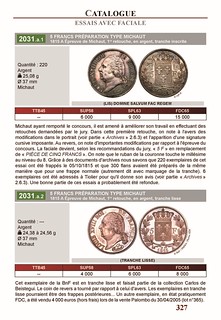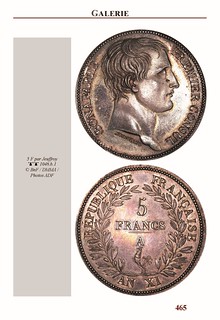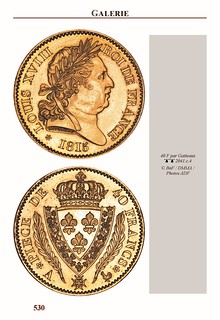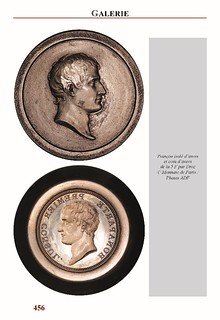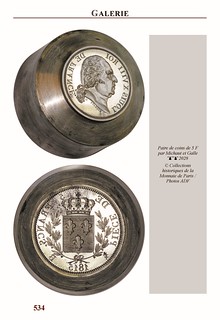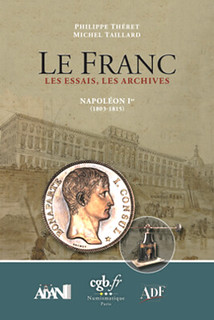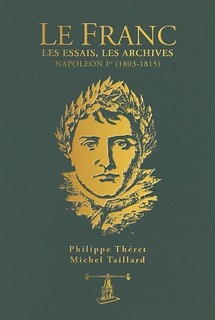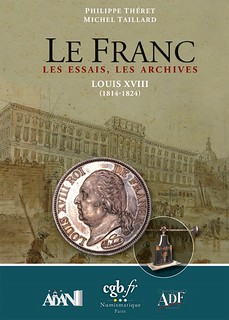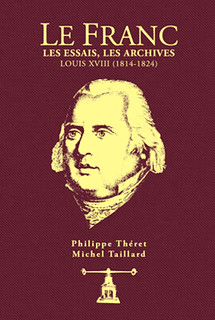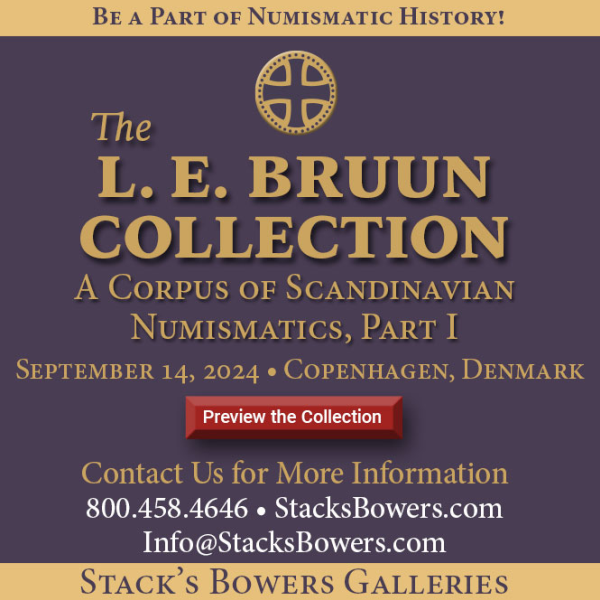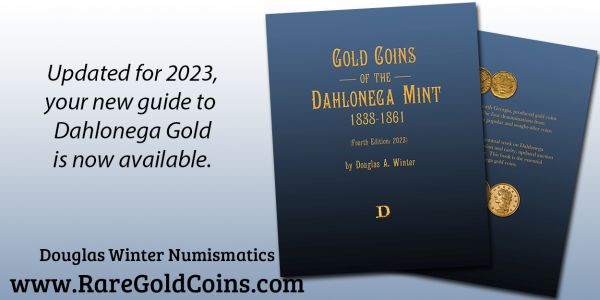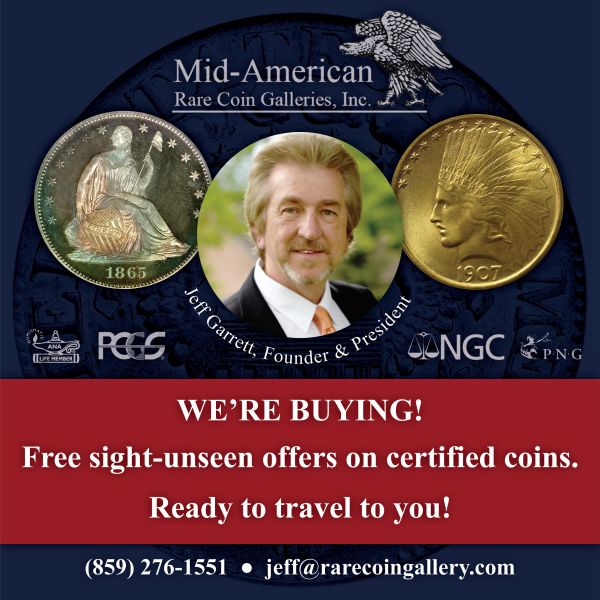
Visit our NBS Sponsors
About UsThe Numismatic Bibliomania Society is a non-profit association devoted to the study and enjoyment of numismatic literature. For more information please see our web site at coinbooks.org SubscriptionsThose wishing to become new E-Sylum subscribers (or wishing to Unsubscribe) can go to the following web page link MembershipThere is a membership application available on the web site Membership Application To join, print the application and return it with your check to the address printed on the application. Print/Digital membership is $40 to addresses in the U.S., and $60 elsewhere. A digital-only membership is available for $25. For those without web access, write to: Jeff Dickerson, Treasurer AsylumFor Asylum mailing address changes and other membership questions, contact Jeff at this email address: treasurer@coinbooks.org SubmissionsTo submit items for publication in The E-Sylum, write to the Editor at this address: whomren@gmail.com BUY THE BOOK BEFORE THE COINSale CalendarWatch here for updates! |
- WAYNE'S WORDS: THE E-SYLUM JULY 21, 2024
- NBS ACTIVITIES AT THE ANA CONVENTION
- KOLBE & FANNING WEB SALE NUMBER 1
- 1793 MINT APPROPRIATION ACT OFFERED
- FRENCH ROYAL GOLD COINS CATALOG OFFERED
- BRITISH BANKING HISTORY BOOKS OFFERED
- NEW BOOK: LE FRANC - CHARLES X
- NEW BOOK: BANKNOTES FROM SHIPWRECKS, 2024
- MICHAEL "STEAMER" STANLEY (1944-2024)
- COINS ACROSS TIME EXHIBIT CATALOG
- VIDEO: OVERVIEW OF COUNTERFEIT COINAGE
- KYLE KNAPP AWARDED HONORARY DOCTORATE
- MORE ON RICHARD AUGUST
- NOTES FROM E-SYLUM READERS: JULY 21, 2024
- ACEF WILL STAMP 'COPY' ON COUNTERFEIT COINS
- VOCABULARY TERM: POT METAL
- JOSEPH HILARIUS ECKHEL (1737-1798)
- STAN KESSELMAN INTERVIEW, PART FIVE
- ERIC SCHENA INTERVIEW, PART TWO
- STACK'S BOWERS OPENS COPENHAGEN OFFICE
- NUMISMAGRAM MEDAL SELECTIONS: JULY 21, 2024
- STACK'S BOWERS OFFERS COLOMBIA PAPER MONEY
- HERITAGE ANA WORLD & ANCIENT SELECTIONS
- WAYNE'S NUMISMATIC DIARY: JULY 21, 2024
- A PROGRESSION OF FISCAL PAPER
- ROMAN COIN HOARD EXHIBITED IN WALES
- COIN FOUND AT ROMAN BATHHOUSE
- COINS OF THE BYZANTINE SUCCESSOR STATES
- THE CHINESE CLOTH BANKNOTE TALK
- NO CASH AT THE PERTH MINT
Content presented in The E-Sylum is not necessarily researched or independently fact-checked, and views expressed do not necessarily represent those of the Numismatic Bibliomania Society.
WAYNE'S WORDS: THE E-SYLUM JULY 21, 2024
 New subscribers this week include:
Erik Douglas.
Welcome aboard! We now have 7,266 subscribers.
New subscribers this week include:
Erik Douglas.
Welcome aboard! We now have 7,266 subscribers.
Thank you for reading The E-Sylum. If you enjoy it, please send me the email addresses of friends you think may enjoy it as well and I'll send them a subscription. Contact me at whomren@gmail.com anytime regarding your subscription, or questions, comments or suggestions about our content.
This week we open with NBS activities at the ANA convention, numismatic literature sales, two new books, an obituary, updates from the Newman Numismatic Portal, and more.
Other topics this week include banking history, banknotes salvaged from shipwrecks, counterfeit coinage and the Hobby Protection Act, pot metal, fixed price and auction selections, Depression scrip, fiscal paper, Roman coin discoveries, and a cloth Chinese banknote.
To learn more about the 1793 Mint Appropriation Act, French Royal gold coins, Mike Stanley, Kyle Knapp, Richard August, Joseph Eckhel, the Stack's Bowers Copenhagen office, Colombia paper money, the Maryland Institute medal, Damaged Pocket Change, and the Perth Mint's No Cash policy, read on. Have a great week, everyone!
Wayne Homren
Editor, The E-Sylum
NBS ACTIVITIES AT THE ANA CONVENTION
As a reminder of the upcoming convention, here's a repeat of Numismatic Bibliomania Society President Len Augsburger's earlier note on planned club activities at the American Numismatic Association World's Fair of Money®. -Editor
 NBS Activities at the ANA Convention
NBS Activities at the ANA Convention
Once again, the ANA Convention will feature a full slate of NBS activities. Our club table on the bourse floor is 1321, conveniently located adjacent to book dealers Kolbe & Fanning and Charles Davis. Tom Harrison will be hosting the club table on Tuesday, with Jeff Dickerson taking over on Wednesday. Jeff has been learning the fine arts of bookbinding and will be doing a demo of box building for attendees. Boxes will be suitably sized to contain back issues of the The Asylum. This is your chance to create a one-of-a-kind commemorative of NBS history!
The NBS Symposium annually showcases presentations related to new books. This year's installment features author Robert D. Leonard, speaking on the upcoming third edition of California Pioneer Fractional Gold, while Len Augsburger will discuss the forthcoming bibliography of Eric P. Newman, to be published by Kolbe & Fanning. This event takes place Thursday at 1:00 PM in room 10.
 The annual Charity Auction will occur during the NBS General Meeting on Friday, 11:30AM in room 12. Auction catalogs will be issued prior to the event so that bidders may plot their strategies accordingly. The Charity Auction provides a good portion of the NBS operating budget, and we thank donors and bidders for their support. In addition, we will present our literary award for 2023.
The annual Charity Auction will occur during the NBS General Meeting on Friday, 11:30AM in room 12. Auction catalogs will be issued prior to the event so that bidders may plot their strategies accordingly. The Charity Auction provides a good portion of the NBS operating budget, and we thank donors and bidders for their support. In addition, we will present our literary award for 2023.
Finally, on Saturday, we will have a tour of the Dan Hamelberg library in Champaign, IL. Transportation and lunch will be provided but we do ask attendees to RSVP to me at leonard.augsburger@wustl.edu. This will leave from the Hyatt Regency in Rosemont at 9:30AM and return in the evening.
To read the earlier E-Sylum article, see:
NBS ACTIVITIES AT THE ANA CONVENTION
(https://www.coinbooks.org/v27/esylum_v27n25a02.html)
THE BOOK BAZARRE
KOLBE & FANNING WEB SALE NUMBER 1
Numismatic Booksellers Kolbe & Fanning have announced a new web sale format to replace their earlier "Buy or Bid" sales of inexpensive but useful literature. The sale closes on July 24, 2024. Good luck, everyone! -Editor
On Wednesday, July 24, Kolbe & Fanning will be holding the first of our new series of Web Sales of Numismatic Books. This new series is intended to replace our former Buy or Bids Sales with a more vibrant and participatory format. Like our Buy or Bid Sales, the new Web Sales will focus on inexpensive but useful books, catalogues and other publications on coins from all times and places. However, they will take place live online, in much the same format as our Premier Auctions, and all lots in the Web Sales will begin at a very low $10 opening bid instead of with an estimate. The catalogue for the first sale is available now at bid.numislit.com.
Our Premier Auctions will continue to be held several times a year in the same format as usual. Customers who participate in those auctions will be able to register for our new Web Sales using their existing log-in information. New bidders will have to establish an account for online bidding by creating an account at bid.numislit.com or using the links to the app below.
The new Web Sales are online-only, with no printed catalogue. The terms of sale are the same as in our Premier Auctions. Bids may be placed at any time after the sale is posted, with the live sale beginning at 12:00 noon (Eastern Time) on Wednesday, July 24. Our intention is to hold these sales more frequently than we held our Buy or Bid Sales. Please note, as stated above, that nothing is changing with our Premier Auctions, which will continue to feature a printed catalogue and be run in the same manner as in recent years.
Thank you for your participation in past sales, and we look forward to continuing to work with you in the future.
To read the complete article, see:
Web Sale #1 of Numismatic Books
(https://bid.numislit.com/auctions/1-9BQ8OZ/web-sale-1-of-numismatic-books)
1793 MINT APPROPRIATION ACT OFFERED
Stack's Bowers is offering a great piece of early U.S. numismatic ephemera in their August 2024 sale. Here's their description of an important founding document - the March 2, 1793 law appropriating funds for the purchase of the land and buildings that would become the Philadelphia Mint, signed by Thomas Jefferson. -Editor
Important Founding Document for the First United States Mint
Boldly Autographed by Thomas Jefferson
Act of March 2, 1793
Act of March 2, 1793 signed by Thomas Jefferson as Secretary of State. "An Act Making Certain Appropriations Therein Mentioned." Laid paper, printed with manuscript autograph and docketing.
12.4 inches x 7.7 inches. An original signed printing of one of the U.S. Mint's most important foundational documents, the appropriations bill authorizing the purchase of the land and buildings that became the first United States Mint, in addition to the salaries for its first employees. Approved by Congress on November 5, 1792 and enacted into law by President George Washington on March 2, 1793, this bill's first order of business is the earliest commitment to building a functioning Federal Mint. While earlier bills authorized the Mint (most notably the Mint Act of April 2, 1792), this act wrote the checks that made the Mint a reality.
After a boilerplate first paragraph, this act gets down to the task at hand:
For purchasing two lots of ground, with the buildings thereon, and for erecting other buildings, and purchasing sundry materials and necessaries for the use of the mint, twelve thousand and seventy-nine dollars and seventy-eight cents.
It continues with a list of the Mint's founding positions and provides for payment of their salaries, retroactive to July 1792, the previous year.
For the salaries of the officers of the mint, from the first day of July to the thirty first day of December, one thousand seven hundred and ninety two, two thousand six hundred and ninety four dollars, and eighty eight cents.
And proceeds to provide for their salaries in 1793, their first full year of employment:
For the salary of the following officers of the mint, for the year one thousand seven hundred and ninety three: the director two thousand dollars; the assayer fifteen hundred dollars; the chief coiner, fifteen hundred dollars; the engraver, twelve hundred dollars; the treasurer, twelve hundred dollars; three clerks, five hundred dollars each, fifteen hundred dollars; for defraying the expenses of workmen, for the year, one thousand seven hundred and ninety three, a sum not exceeding two thousand six hundred dollars.
The act continues with other appropriations, including the cost of delivering Presidential votes to the seat of government.
This copy is signed by Thomas Jefferson as Secretary of State, likely because it was distributed (perhaps to a member of Congress or another member of the government) from his office. This is a separate one page offprint that stands on its own, as issued; it is not a page removed from a book of proceedings.
Another individual has inked Jefferson's name at the broad right margin in the era, an official docketing that indicates from whom the document came. A later individual, during this document's life as collectible, has bracketed the Mint-related content at left margin in pencil and rewritten the word "officers" that was largely missing from the text. Several folds are seen, some producing areas of eternal weakness or closed splits. The horizontal folds are heaviest, producing a split at the right margin, though a vertical fold creates a central lacuna and affects the H of Th. in Jefferson's autograph. Some toning is seen, but the overall visual appeal is excellent. The top margin is uneven, as issued. An ink notation left of SECOND has been struck out, leaving a stain on the verso.
Signed in hand by Jefferson, this document is the only copy we've encountered. We handled it nearly 20 years ago, in 2006, when it brought $41,400. While the Jefferson autograph is valuable, the most important aspect of this document is its status as a witness to history: printed as the human and physical resources of the First U.S. Mint were being assembled, during the exact time the nascent mint was involved in the coining of the 1793 Chain cents. This document bridges the gap from the patterns and plans of 1792 to their full manifestation in 1793. This would be a landmark addition to any advanced numismatic collection.
Provenance: From our sale of the Old West and Franklinton Collections, August 2006, lot 16.
To read the complete article, see:
Act of March 2, 1793 signed by Thomas Jefferson as Secretary of State. "An Act Making Certain Appropriations Therein Mentioned."
(https://auctions.stacksbowers.com/lots/view/3-1B97PS/act-of-march-2-1793-signed-by-thomas-jefferson-as-secretary-of-state-an-act-making-certain-appropriations-therein-mentioned-laid-pa)
FRENCH ROYAL GOLD COINS CATALOG OFFERED
The Coin & Currency Institute is offering the new catalog of the Royal gold coins of France for sale in the U.S. Here's their announcement. -Editor
The Department of Coins, Medals, and Antiquities at the National Library of France (Bbibliothèque Nationale) boasts the world's most extraordinary collection of French royal gold coins. A new two-volume set on them was just published by Editions Gadoury of Monaco and the National Library that is a virtual catalog of the collection, including its many extremely rare and unique specimens.
The 320 pages in volume 1 of Catalogue de Monnaies Royales Françaises lists and describes the gold coinage of Louis IX to Louis XII (1226-1514). The second one is 304 pages and focuses on the gold coins from the reigns of François I to Louis XVI (1515-1793). Coins are fully described in French with 1,000 illustrations in color and in actual size. The date, weight, and how each piece was acquired are cited, as are cross references. There is also a bibliography.
The catalog has been compiled by Jean-Yves Kind, an archivist and former special advisor on the Conservation of Treaties at the Ministry of Foreign Affairs. He has managed the French coin collection at the National Library of France since 2009. He is a prolific author of numerous books and articles on numismatics, primarily published in the Revue Numismatique and the Bulletin of the French Numismatic Society.
Each hard bound book measures 12 x 8.25 inches. The set comes in a slipcase and will be available in August. It is $135.00 plus $7.75 shipping and handling in the U.S. Contact Coin & Currency Institute, 34 Blair Park Road, Suite 104–188, Williston, Vermont 05495. Toll-free 1-800-421-1866. Fax 802-536-4787. E-mail: mail@coin-currency.com. Ordering information and sample pages are at www.coin-currency.com.
To read the earlier E-Sylum article, see:
NEW BOOK: CATALOG OF FRENCH ROYAL GOLD COINS
(https://www.coinbooks.org/v27/esylum_v27n23a04.html)
BRITISH BANKING HISTORY BOOKS OFFERED
For bibliophiles and students of banknotes and banking history, Tennant's Auctioneers is offering a bulk lot of British banking history books. -Editor
Collected Banking History and Banknote Reference Books, containing English Paper Money catalogues, Histories of The Bank of England, Lloyds, Hoares, provincial banks etc.. a comprehensive collection for any enthusiast on the subject (40 books)
Estimate
£100 - £200
Buyer's premium: 24.00%
To read the complete lot description, see:
Collected Banking History and Banknote Reference Books
(https://auctions.tennants.co.uk/auction/lot/lot-442---collected-banking-history-and-banknote/?lot=2486719)
NEW BOOK: LE FRANC - CHARLES X
Laurent Schmitt submitted this announcement of the third volume of the series of books by Philippe Théret and Michel Taillard on French essays from 1803 to 1870. Thank you. Information on the other volumes is included as well. -Editor
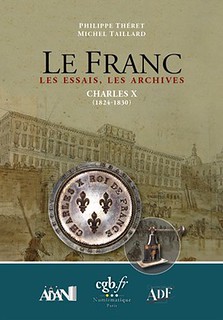 Philippe Théret and Michel Taillard have worked to provide collectors and professionals with new tools to approach the fascinating field of French essays of the period 1803 to 1870. That is to say from the creation of the Germinal Franc under Napoleon Bonaparte to the fall of Napoleon III. They were supported by the associations ADF (Friends of the Franc) and ADAN (Friends of Numismatic Authors), CGB (numismatic company and Editor) and by subscribers and sponsors.
Philippe Théret and Michel Taillard have worked to provide collectors and professionals with new tools to approach the fascinating field of French essays of the period 1803 to 1870. That is to say from the creation of the Germinal Franc under Napoleon Bonaparte to the fall of Napoleon III. They were supported by the associations ADF (Friends of the Franc) and ADAN (Friends of Numismatic Authors), CGB (numismatic company and Editor) and by subscribers and sponsors.
The field of essays is wide: coin design contest essays, design trials, trial strikes, patterns, branch mint trials, political propaganda essay strikes (Napoleon II, Henri V...), presentation strikes for dignitaries, proof strikes, restrikes for collectors, Mint Visit strikes (Paris mint and branch mints)...
A collection of six volumes (one per period) are scheduled. The first volume covering the period of Napoleon I, from 1803 to 1815 was released in autumn 2023, the second about Louis XVIII was released in june 2024, Charles X is planned for november 2024, Louis-Philippe for november 2025, 2nd Republic for november 2026 and finally Napoléon III for november 2027.
The most important public institutions have collaborated in the realization of these works:
- The Monnaie de Paris opened the doors of its cabinet (4,500 photos taken) but also those of the redzone of the Pessac mint, where the museum's monetary tools are kept (12,000 photos taken);
- The BnF (Bibliothèque Nationale de France) allowed us to study and photograph their prestigious 19th century period, numismatic collections (5,000 photos taken);
- The Carnavalet Museum and its most precious numismatic collection (2,500 photos taken);
- The cabinet of the Bibliothèque Royale de Belgique.
In addition to these important contributions, 160,000 pages of archives have been digitized and examined over the past 20 years. This has allowed us to better understand the essays and in many cases the manufacturing figures!
For this series of books, the structure of each book is the same: the first part is dedicated to the archives, a second part dedicated to the census catalog (with price quotes) and finally a third part with full page photo plates.
For more information contact us at : essais@amisdufranc.org
For more information, or to order the earlier volumes, see:
lf27 - Le Franc Les Essais, Les Archives - Napoléon Ier (1803-1815) THÉRET Philippe, TAILLARD Michel
(https://www.cgbfr.com/le-franc-les-essais-les-archives-napoleon-ier-1803-1815-theret-philippe-taillard-michel,lf27,a.html)
lf28 - Le Franc Les Essais, Les Archives - Louis XVIII (1814-1824) THÉRET Philippe, TAILLARD Michel
(https://www.cgbfr.com/le-franc-les-essais-les-archives-louis-xviii-1814-1824-theret-philippe-taillard-michel,lf28,a.html)
To read the earlier E-Sylum article, see:
NEW BOOK: LE FRANC - NAPOLEON I
(https://www.coinbooks.org/v26/esylum_v26n48a04.html)
NEW BOOK: BANKNOTES FROM SHIPWRECKS, 2024
Roland Rollins has published an update to his book on banknotes and shipwrecks. Here's his announcement. Congratulations! -Editor
 I've released an updated book, "Banknotes Salvaged, Looted, or Lost From Shipwrecks"
I've released an updated book, "Banknotes Salvaged, Looted, or Lost From Shipwrecks"
When I wrote "200 Years of Banknotes Salvaged, Looted or Lost from Shipwrecks" I made this statement about the future use of ships to transport banknote shipments: "Multiple shipments via air might be more prudent". It would appear my opinion was completely off base! Or at least not heeded. As one would expect, open discussions of such a huge investment do NOT appear in the news or online. BUT, banknote shipments looted or seized while on board ship is an entirely different matter. THAT'S NEWS! And yes, I've found FOUR such cases from 2006 to 2019.
Since the losses now cover 240 years a new "Banknotes Salvaged, Looted, or Lost From Shipwrecks" book is published! It is perfect bound to allow the title to appear on the binding. Also, I upgraded to thicker 80# coated paper.
- Most shipwrecks have a chart with banknotes involved, map of wreck site, image of ship, and banknote images.
- Lost ships was 36 , now 52
- Date ranges of losses was 1882 to 1979 now 1779 to 2019
- Banknote printers with lost consignments was 8 now 14
- Banknote denominations was 74 now 105 - from 45 countries
- Pages was 56 now 90
To order for $20 + $5 US shipping or $11 International shipping, go to my web page here: http://currency_den.tripod.com/salvage/salvage.html
To read the earlier E-Sylum article, see:
NEW BOOK: BANKNOTES FROM SHIPWRECKS
(https://www.coinbooks.org/v25/esylum_v25n39a04.html)
MICHAEL "STEAMER" STANLEY (1944-2024)
Pete Smith submitted this remembrance of Mike Stanley. -Editor
 At one time, I was involved with the ANA Representative program. Twenty-Five years ago, I was a
District Delegate from Minnesota and Mike Stanley was a District Delegate from California. I would see
him at the ANA Representative's breakfasts at the World's Fair of Money.
At one time, I was involved with the ANA Representative program. Twenty-Five years ago, I was a
District Delegate from Minnesota and Mike Stanley was a District Delegate from California. I would see
him at the ANA Representative's breakfasts at the World's Fair of Money.
Mike was born in San Francisco. His collection evolved from an 1864 Two-Cent piece given by his grandmother when he was four. He joined the San Francisco Coin Club in 1960.
I recall one year he made a presentation at the breakfast. He was a very energetic and enthusiastic supporter of the ANA. Later in 2008, he was promoted to assistant national coordinator.
Mike received an ANA President's Award in 1997 and 1999. He received the Glenn Smedley Memorial Award in 1988 and the ANA Medal of Merit in 1989. The Numismatist stated that he was a member of 47 local, regional and national clubs. In 2000. He began working as an ANA Volunteer at the national shows.
He was typical of those who were named a Numismatic News Numismatic Ambassador, working at the local and regional level. He was a frequent speaker, exhibitor, bourse chair and officer in various clubs.
Here's an excerpt from his online obituary. -Editor
 Mike Stanley passed away peacefully of natural causes on the morning of Wednesday June 26, 2024 at his Care Home in Walnut Creek. Mike was born to Virginia and Milan Stanley. He is the eldest of 5 brothers raised in Daly City, CA. He attended Our Lady of Perpetual Help ( OLPH) elementary and then onto Junipero Serra High School class of 1962. Shortly after High School, he began his 20 year U.S. Naval career in communications and served on the USS Enterprise CVN 65 Aircraft carrier. Among many of his career adventures Mike became a Radio DJ while stationed on Midway Island. It was there he popularized the "Uncle Steamer's good ole' Rockin' Roll show". He became known for his story telling and card tricks as well.
Mike Stanley passed away peacefully of natural causes on the morning of Wednesday June 26, 2024 at his Care Home in Walnut Creek. Mike was born to Virginia and Milan Stanley. He is the eldest of 5 brothers raised in Daly City, CA. He attended Our Lady of Perpetual Help ( OLPH) elementary and then onto Junipero Serra High School class of 1962. Shortly after High School, he began his 20 year U.S. Naval career in communications and served on the USS Enterprise CVN 65 Aircraft carrier. Among many of his career adventures Mike became a Radio DJ while stationed on Midway Island. It was there he popularized the "Uncle Steamer's good ole' Rockin' Roll show". He became known for his story telling and card tricks as well.
Mike met and married his wife Nancy of 43 years until her passing in 2018. They resided in Concord and raised their two children there. Mike retired from the US Navy and went on to the next 23 years working as a US Postal carrier for the city of Antioch. He later worked for the next 16 years being a security guard and catching bad guys. Mike then went onto becoming the Commander of the VFW Post 5182 and the American Legion Post 331.
Over the years Mike was very passionate about coin collecting. He was a member of numerous Numismatics clubs on local and national levels. He achieved the Numismatic Ambassador Award in 2000. Mike was also an avid SF Giants, 49ers, and Warriors fan. He very much enjoyed attending games when he could. His hobbies over the years also included bowling and collecting baseball cards. He enjoyed being the announcer for card shows and introducing sports celebrities as well as special guests.
John and Nancy Wilson of Ocala, FL write:
"It has been many years since we have heard from our good friend Mike "Steamer" Stanley, and are deeply saddened over his recent passing. He is now with the love of his life, his wife Nancy. Over many years Steamer has been on our greeting card and email list; Years back we were always happy to see and talk to him at ANA and California events or shows that we attended.
"Steamer was a dedicated coin show worker not only for the many California coin clubs he belonged to but also for the ANA where at one time he handled the message center. We will always remember when Steamer and Mike Mr. T. as we like to call him went to the Canadian Numismatic Association show back in the early 2000's, when I John was the ANA President. Michael "Steamer" Stanley was a force in the hobby and will be greatly missed by his many friends in the Numismatic hobby. Our deepest sympathies to his family."
Thanks, everyone. -Editor
To read the complete online obituary, see:
Mr. Michael "Steamer" Milan Stanley
(https://everloved.com/life-of/michael-milan-stanley/obituary/)
COINS ACROSS TIME EXHIBIT CATALOG
The latest addition to the Newman Numismatic Portal is the catalog for the Coins Across Time exhibit catalog. Project Coordinator Len Augsburger provided the following report. -Editor
Coins Across Time Exhibit Catalog
Featured at Washington University in St. Louis for the spring 2024 semester, the exhibit Coins Across Time covered various aspects of numismatics from the ancient period to the modern. Exhibits included:
-
 Selections from the John Max Wulfing Collection
Selections from the John Max Wulfing Collection
- Medals of American Independence
- Washingtoniana: Token and Medals Honoring the First President
- Freedom Will Be Ours: Medals and Money in Black America
- Eric P. Newman and Numismatics
- J.S.G. Boggs and the Meaning of Money
- Digitization in Numismatics
Newman Portal has now posted the exhibit catalog, and acknowledges lenders to the exhibit, including the ANA Money Museum (via Curator Doug Mudd), Wayne Homren, John Kraljevich, Stu & Maureen Levine, Joel Orosz, the Resolute Americana Collection, Henry Warshaw, and the John Max Wulfing Collection at Washington University (via Curator William Bubelis). Certain images of the Washington pieces in the catalog are courtesy of Stack's Bowers, while catalog design, photography, and layout were handled by Lianna Spurrier.
Our fall 2024 exhibit will feature Operation Bernhard material on loan from the Florence and Laurence Spungen Family Foundation. This World War II German Nazi scheme produced counterfeit British bank notes, using concentration camp labor. Genuine and counterfeit notes will be on exhibit, in addition to other related objects.
Image: cover of the Coins Across Time exhibit catalog
Link to the Coins Across Time exhibit catalog:
https://archive.org/details/coinsacrosstime2024
VIDEO: OVERVIEW OF COUNTERFEIT COINAGE
The David Lisot Video Library on the Newman Numismatic Portal can be found at:
https://nnp.wustl.edu/library/multimediadetail/522852
We highlight one of his videos each week in The E-Sylum. Here's one from 2005 with Chris Pilliod speaking about counterfeit coinage. -Editor
Counterfeit coinage has plagued collectors for decades. This presentation discusses the diagnostics and manufacturing methods employed by the fakers.
From the 2005 American Numismatic Association summer convention.
Speaker(s): Christopher Pilliod.
To watch the complete video, see:
Overview of Counterfeit Coinage
(https://youtu.be/fSNWuWrZnZ0)
KYLE KNAPP AWARDED HONORARY DOCTORATE
Longtime PCGS grader and numismatist Kyle Knapp was awarded an honorary Doctor of Numismatics degree by the ANA for his years of service to numismatic education. Here's the announcement from PCGS. -Editor
 Professional Coin Grading Service (www.PCGS.com) principal grader
Kyle C. Knapp was recently awarded an honorary Doctor of Numismatics degree by the
American Numismatic Association (ANA). The degree was conferred upon Knapp during the
American Numismatic Association's Summer Seminar, an educational series that has been held
annually for five decades.
Professional Coin Grading Service (www.PCGS.com) principal grader
Kyle C. Knapp was recently awarded an honorary Doctor of Numismatics degree by the
American Numismatic Association (ANA). The degree was conferred upon Knapp during the
American Numismatic Association's Summer Seminar, an educational series that has been held
annually for five decades.
"We are so proud of Kyle, a top grader who has been a member of our team here since 2018," said PCGS President Stephanie Sabin. "Kyle embodies so many of the principles at the core of what we do here at PCGS, including educating the public. This degree was bestowed at the ANA's Summer Seminar, which has been a popular numismatic rite of passage for generations now."
Sabin added, "We send many of our graders and other numismatic experts to this yearly educational program because we not only want to support those who attend the courses held there, but we also want to share our vast resources with as many people in our hobby as we can."
Knapp said, "I am very grateful to the ANA for the opportunity to have been a part of Summer Seminar for so long. I began attending as a young numismatist, and the information and guidance so generously shared by top experts and the community as a whole opened for me a career path more rewarding and enjoyable than I could have imagined. The dearth of numismatic courses in formal academics makes generational transfers of knowledge like those found at the Summer Seminar essential for the continued growth of our hobby."
There are many free PCGS educational resources available online. These include PCGS CoinFacts (https://www.pcgs.com/coinfacts), PCGS Population Report (https://www.pcgs.com/pop), PCGS Price Guide (https://www.pcgs.com/prices), and PCGS News & Articles (https://www.pcgs.com/news).
Congratulations! Well deserved. Kyle is also an avid bibliophile and supporter of NBS and The E-Sylum through his weekly Auditorium Books ads and Sponsorship banners. Auditorium Books not only has an extensive website, there is a physical store in Los Angeles, open daily 11am-7pm, with a regular presence on social media as well. Check it out for a wide range of fiction and nonfiction titles, including hundreds of excellent numismatic works. -Editor
To visit Auditorium Books, see:
https://auditoriumbooks.com/
Some numismatic listings:
https://auditoriumbooks.com/search?q=coin
https://auditoriumbooks.com/search?page=5&q=numismatic
https://auditoriumbooks.com/search?q=money
MORE ON RICHARD AUGUST
The Boston Globe published an obituary of Dick August. -Editor
 AUGUST, Richard Age 84, of Providence RI, entered into rest on July 13, 2024 after a brief illness. Richard was born on May 10,1940 and raised in Brookline MA. He attended the University of Virginia for undergraduate studies and obtained a master's degree in philosophy from Brown University. A longtime resident of Providence, Richard was a world class numismatist, a first-rate runner and track coach and a brilliant math teacher. Richard gave generously of himself during his lifetime as a coach and a tutor. He guided countless people in the Providence area to better math skills and faster running times. He was a passionate gardener who took great pride in tending to the gardens of his many friends.
AUGUST, Richard Age 84, of Providence RI, entered into rest on July 13, 2024 after a brief illness. Richard was born on May 10,1940 and raised in Brookline MA. He attended the University of Virginia for undergraduate studies and obtained a master's degree in philosophy from Brown University. A longtime resident of Providence, Richard was a world class numismatist, a first-rate runner and track coach and a brilliant math teacher. Richard gave generously of himself during his lifetime as a coach and a tutor. He guided countless people in the Providence area to better math skills and faster running times. He was a passionate gardener who took great pride in tending to the gardens of his many friends.
To read the complete online obituary, see:
RICHARD AUGUST Obituary
(https://www.legacy.com/us/obituaries/bostonglobe/name/richard-august-obituary?id=55571801)
Anthony Terranova of New York City writes:
"My heart is saddened with the news of his passing. He was an extremely respected part of my numismatic life. We always had insightful phone conversations after major sales for the past 45 years. Also, he was a great source of very choice and rare type coins and medals. I will personally miss him greatly!!"
Jim Glickman writes:
"I was saddened to hear of Dick's passing, and have enjoyed reading everyone's thoughtful tributes. Dick was always friendly to me, and he liked to ask specifically what I was collecting. He showed genuine interest, and often gave detailed and helpful advice about what to look for and how to collect, especially when I was starting out. (Phone calls with him were never short, and would span several interesting topics.) If I showed him a coin that I had purchased, his comments became valuable learning experiences. I will treasure the coins and colonial currency that I bought from him over the years, and more importantly will treasure my memories of him. His unique voice will remain in my head. RIP."
Mark Vitunic writes:
"Dick August was buried Wednesday in Sharon, MA following a graveside service attended by about 40 people. C4 was represented by Jim Rosen, Tom Gesner, Kevin Vinton, and Mark Vitunic. Following eulogies covering each of Dick's "other" passions of teaching, running, and gardening, Jim Rosen provided one covering the numismatic aspect of Dick's life, filled with entertaining stories of quirky things we can all imagine only Dick doing. At the burial, three counterfeit George III halfpence were added to the dirt, in the hopes that Dick will enjoy many hours in the afterlife trying to attribute them. RIP, Dick."
Jeff Rock writes:
"Mark, what a fitting gesture, I can imagine Dick chuckling over that!"
To read the earlier E-Sylum article, see:
RICHARD AUGUST (1940-2024)
(https://www.coinbooks.org/v27/esylum_v27n28a09.html)
NOTES FROM E-SYLUM READERS: JULY 21, 2024
 More on the Latest British Museum "Theft"
More on the Latest British Museum "Theft"
Len Augsburger writes:
"The "performance art" theft from the British Museum is a misguided attempt to focus discussion on the issue and only succeeds in degrading public trust in this foundational institution. If the artist wishes to improve security and access at the BM, there are far more constructive ways to do so. Instead, this "act" of public shaming merely encourages would-be thieves to engage in the worst sort of theft, one that steals from everyone at once."
I had to restrain myself from using the word "stunt" more than once in my commentary last week. I should have also put "performance art" in quotes - it may have been a performance, but I wouldn't call it art, either. Just a weird, sad stunt.
Michael Kodysz passed along this additional article. Thanks, everyone. -Editor
To read the complete article, see:
Another object has been stolen from the British Museum—but this time by an artist
(https://www.theartnewspaper.com/2024/07/15/another-object-has-been-stolen-from-the-british-museumbut-this-time-by-an-artist)
To read the earlier E-Sylum article, see:
ARTIST SNATCHES BRITISH MUSEUM COIN
(https://www.coinbooks.org/v27/esylum_v27n28a27.html)
Not George, but William
Martin Purdy writes:
"There's a bit of a slip in the description of the first image in the "defaced coins" article in last week's newsletter, as the monarch on the shilling isn't George III but William III ("GVLIELMVS"). The B mintmark shows it's one of the coins struck in Bristol during the recoinage of 1696-97. "
Great catch - thanks. -Editor
To read the earlier E-Sylum article, see:
COINS DEFACED FOR POLITICS
(https://www.coinbooks.org/v27/esylum_v27n27a28.html)
Standard Catalog of World Paper Money Editions
Last week Ken Berger asked me:
"Do you know what year the first edition of the Standard Catalog of World Paper Money (SCWPM) - Specialized Issues was released?"
I did not, and since I was travelling I reached out to former SCWPM editor George Cuhaj, who was also travelling and unable to assist. However, Ken was later able to find the answer, and he submitted this summary for our readers. Thank you. -Editor
SCWPM
1st - 1975
2nd - 1977
3rd - 1980
At this point it split into 2 different volumes
Specialized Issues (Vol. 1)
4th - 1984
5th - 1986
6th - 1990
7th - 1995
8th - 1998
9th - 2002
10th - 2005
11th - 2009
12th - 2013 (last edition)
General Issue (Vol. 2)
4th - 1982
5th - 1986
6th - 1990
7th - 1994
8th - 1996
9th - 2000
10th - 2003
11th - 2006
12th - 2008
13th - 2010
14th - 2012
15th - 2014
16th - 2016 (last edition)
RNS Awards London Mint of Constantius & Constantine
Hugh Cloke writes:
 "At a conference in York we received an award from the Royal Numismatic Society for one of the two "best publications relating to the late Roman coinage of the Western Empire after the currency reforms of Aurelian....The award acknowledges your contribution to the study of numismatics in the late Roman period."
"At a conference in York we received an award from the Royal Numismatic Society for one of the two "best publications relating to the late Roman coinage of the Western Empire after the currency reforms of Aurelian....The award acknowledges your contribution to the study of numismatics in the late Roman period."
"The other award recipient was Eleanor Ghey of the British Museum for her study of Tetrarchic hoards.
"You posted publication announcements for both books in earlier issues. I've attached a copy of our award letter from the conference.
"Readers interested in purchasing our book can follow this link to Charlie Davis's website. He is the US distributor of the book:
https://www.vcoins.com/en/stores/charles_davis/44/product/
cloke__toone_london_mint_of_constantius__constantine_
2nd_edition/2093379/Default.aspx
Eleanor's book is available from the British Museum at:
https://www.amazon.co.uk/Recent-Discoveries-Tetrarchic-
Britain-Context/dp/0861592360/ref=sr_1_fkmr1_1
"
Congratulations! -Editor
To read the earlier E-Sylum article, see:
NEW BOOK: THE LONDON MINT, 2ND ED.
(https://www.coinbooks.org/v27/esylum_v27n26a02.html)
ACEF WILL STAMP 'COPY' ON COUNTERFEIT COINS
The Anti-Counterfeiting Educational Foundation (ACEF) is offering to stamp "COPY" on counterfeit coins brought to their table at the upcoming American Numismatic Association show. Here's the press release. -Editor
Make your counterfeit coins legal to own!
 What do you do with counterfeit coins you unwittingly purchased?
What do you do with counterfeit coins you unwittingly purchased?
According to federal law, counterfeit coins are illegal to possess, buy or sell. Hence, once a victim becomes aware that the coin is counterfeit, he/she should turn it over to the nearest Secret Service agent or local law-enforcement official. Often that is impractical because of distance or law enforcement being reluctant to spend time to recover one or two counterfeit items, especially fake coins.
There is another remedy. Have the word "COPY" incused on either the back or front of the coin so that it complies with the Hobby Protection Act, rendering the counterfeit legal to possess.
Problem: Other than private and government mints, there a few entities that have the knowledge and equipment to properly stamp the word COPY on a counterfeit coin.
As a public service, the non-profit Anti-Counterfeiting Educational Foundation (ACEF) will properly mark COPY on up to three counterfeit coins per owner free of charge at Table No. 1928 located on the bourse during the World's Fair of Money Aug. 7 through 10 at the Donald E. Stephens Convention Center, Rosemont, IL.
"We want to help victims to legally possess the counterfeits they have been duped into buying, especially on the Internet. Perhaps more importantly, we want them to come to the WFOM to see real coins and meet real dealers who are trusted professionals that will treat them fairly," said ACEF President John Albanese."
The punches and other equipment used to mark the fake coins with the word COPY mark were made and donated to the ACEF by Joe Paonessa of the private Root River Mint, Racine, WI.
ACEF is a 501(C)(3)non-profit corporation with Public Charity status. It is funded entirely by donations. For news and informative articles, as well as donating, visit ACEF's website: www.acefonline.org
For more information on the Root River Mint, see:
https://rrmint.com/
VOCABULARY TERM: POT METAL
Here's another entry from Dick Johnson's Encyclopedia of Coin and Medal Terminology. -Editor
Pot Metal. An alloy without specific formulation but which is made by melting scrap in a pot, hence the name. Pot metal generally has a high content of lead, with a lesser amount of white metals, and sometimes, copper. It is characteristically low cost, quite pliable at room temperature, low melting point and ease of fabrication. Such a soft metal alloy is also called amalgam. Pot metal was used extensively from 1920 to World War II by Japanese manufacturers to produce cheap souvenir metal relief objects – trays, small plates, ashtrays, boxes and such. These had relief scenes – modeled from postcards or photos – were cheaply molded or fabricated and usually finished with a tinted lacquer. They are seldom found today in pristine condition as they are easily bent and disfigured because of their soft composition, called soft metal distortion.
To read the complete entry on the Newman Numismatic Portal, see:
Pot Metal
(https://nnp.wustl.edu/library/dictionarydetail/516529)
JOSEPH HILARIUS ECKHEL (1737-1798)
E-Sylum Feature Writer and and Coryphaeus American Numismatic Biographies, Pete Smith submitted this article on the "Father of Numismatic Science." Thanks! -Editor
This week I step out of my comfortable rut, writing about American numismatics personalities, and into the broad area of world numismatics. My topic is the man called the father of numismatic science.
In about 1960, my father bought a set of the 1911 Encyclopedia Brittanica from a neighbor. The set is now in my library. It is not often that I get the opportunity to quote it. This listing has not improved since 1911.
 "ECKHEL. JOSEPH HILARIUS (1737-1798). Austrian numismatist. Was born at Enzersfeld
in lower Austria, 1737. His father was the farm-steward to Count Zinzendorf, and he received his
early education at the Jesuits' College, Vienna, where at the age of fourteen he was admitted to
the order. He devoted himself to antiquities and numismatics. After being engaged as professor
of poetry and rhetoric, first at Steyer and afterwards at Vienna, he was appointed in 1772 keeper
of the cabinet of coins at the Jesuits' College, and in the same year he was sent to Italy for the
purpose of personal inspection and studies of antiquities and coins. At Florence he was employed
to arrange the collection of the grand duke of Tuscany; and the first-fruits of his study of this and
other collections appeared in his Numi veteres anecdoti, published in 1773. On the dissolution of
the order of Jesuits in 1773, Eckhel was appointed by the empress Maria Theresa professor of
antiquities and numismatics at the university of Vienna, and this post he held for twenty-four
years. He was in the following year made keeper of the imperial cabinet of coins, and in 1779
appeared his Catalogus Vindobonensis numorum veterum. Eckhel's great work is the Doctrina
numorum veterum in 8 vols., the first of which was published in 1792. The author's rich learning,
comprehensive grasp of his subject, admirable order, and precision of statement, in this
masterpiece drew from Heyne enthusiastic praise, and the acknowledgement that Eckhel, as the
Coryphaeus of numismatists, had, out of the mass of previously loose and confused facts,
constructed a true science. A volume of Addenda, was published in 1826. Among his other
works are Choix de pierres gravees du Cabinet Imperial des Antiques (1788), a useful school-book on coins entitled Kurzgefasste Anfangsgrunde zur alten Numismatik (1787), of which a
French version enlarged by Jacob appeared in 1823, &c. Eckhel died at Vienna on the 16th of
May 1798."
"ECKHEL. JOSEPH HILARIUS (1737-1798). Austrian numismatist. Was born at Enzersfeld
in lower Austria, 1737. His father was the farm-steward to Count Zinzendorf, and he received his
early education at the Jesuits' College, Vienna, where at the age of fourteen he was admitted to
the order. He devoted himself to antiquities and numismatics. After being engaged as professor
of poetry and rhetoric, first at Steyer and afterwards at Vienna, he was appointed in 1772 keeper
of the cabinet of coins at the Jesuits' College, and in the same year he was sent to Italy for the
purpose of personal inspection and studies of antiquities and coins. At Florence he was employed
to arrange the collection of the grand duke of Tuscany; and the first-fruits of his study of this and
other collections appeared in his Numi veteres anecdoti, published in 1773. On the dissolution of
the order of Jesuits in 1773, Eckhel was appointed by the empress Maria Theresa professor of
antiquities and numismatics at the university of Vienna, and this post he held for twenty-four
years. He was in the following year made keeper of the imperial cabinet of coins, and in 1779
appeared his Catalogus Vindobonensis numorum veterum. Eckhel's great work is the Doctrina
numorum veterum in 8 vols., the first of which was published in 1792. The author's rich learning,
comprehensive grasp of his subject, admirable order, and precision of statement, in this
masterpiece drew from Heyne enthusiastic praise, and the acknowledgement that Eckhel, as the
Coryphaeus of numismatists, had, out of the mass of previously loose and confused facts,
constructed a true science. A volume of Addenda, was published in 1826. Among his other
works are Choix de pierres gravees du Cabinet Imperial des Antiques (1788), a useful school-book on coins entitled Kurzgefasste Anfangsgrunde zur alten Numismatik (1787), of which a
French version enlarged by Jacob appeared in 1823, &c. Eckhel died at Vienna on the 16th of
May 1798."
My father did not acquire the 1913 Catholic Encyclopedia which provides additional information on Eckhel. His father was Johann Anton Eckhel. After transcribing the above, I did not feel like transcribing the entire listing from The Catholic Encyclopedia. I will include a few quotes.
"His delivery is described as being simple, clear, instructive, inspiring, and often abounding in humour. He was highly regarded by his pupils. That he also enjoyed high repute among his colleagues is attested by his appointment as dean of the philosophical faculty in 1789. However, he soon resigned this position."
This includes a later quote from Friederich Kenner:
"Misguided dilettantism had produced most mischievous results in the field of Numismatics. Lack of system, want of critical judgement, and the disorderly arrangement of the literature had begotten confusion and distrust, which prevented numismatists from taking the place among other sciences to which it was entitled. … Numismatics, hitherto despised, he changed into a kind of encyclopedia of classical antiquities, which includes extensive and much-used sources for other branches of archaeology."
Prior to Eckhel's work, coin collections were generally described in alphabetical order and with little historical context. Eckhel organized coins according to the cities, other than Rome, where they were issued. He organized Roman coins based on chronology.
The Eckhel system is now called "Eckhelsche Ordnung." In addition to the organization, Eckhel corrected previous misattributions and identified spurious coins.
As with many first attempts, Eckhel made some errors in attribution. Numismatic science allows for corrections to be made as new information is developed.
If you wish to read Doctrina numorum veterum in Latin, it is available on Internet Archive. I suspect that few readers of The E-Sylum will take the opportunity. I also suspect there were few readers of coin books in Latin when this was published in 1792. The series may have revolutionized the organization of scholarly works, but they failed to popularize the hobby.
For their tenth anniversary in 1880, The Numismatic Society of Vienna commissioned a medal in honor of Eckhel, The metal for the medal came from melted ancient coins. How many ancient coins were sacrificed to make the medals?
In 1972, a side street was named for him in Vienna.
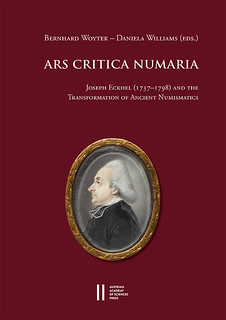 In 2015, from May 27 to 30, a conference was held at the Austrian Academy of Sciences,
organized by Bernard Woytek and Daniela Williams. The conference featured 21 speakers.
In 2015, from May 27 to 30, a conference was held at the Austrian Academy of Sciences,
organized by Bernard Woytek and Daniela Williams. The conference featured 21 speakers.
Just two years ago in 2022, a book on Eckhel was published. Ars critica numaria, Joseph Eckhel (1737-1798) and the development of numismatic method. The book was compiled by Bernard Woytek and Daniela Williams from the papers presented at the 2015 conference on Eckhel. A PDF version of the book my be found at https://austriaca.at/0xc1aa5576_0x003da939.pdf
To read the earlier E-Sylum articles, see:
INTERNATIONAL CONFERENCE ON JOSEPH ECKHEL A SUCCESS
(https://www.coinbooks.org/esylum_v18n30a23.html)
NEW BOOK: ARS CRITICA NUMARIA
(https://www.coinbooks.org/v25/esylum_v25n38a03.html)
STAN KESSELMAN INTERVIEW, PART FIVE
Greg Bennick's latest interview for the Newman Numismatic Portal is with New York dealer Stan Kesselman. Here's the fifth part, where Stan talks about collector R.L. Miles, dealer Eddie Shapiro, and getting an education from wealthy collectors. -Editor
GREG BENNICK: Are there coins that you wish you handled that you never had a chance to?
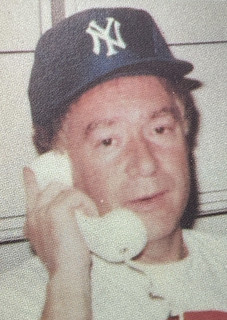 STANLEY KESSELMAN: I was only doing this part time. So, my first biggest customer was R.L. Miles. I don't know if you heard of him. There was a Stacks sale way back.
STANLEY KESSELMAN: I was only doing this part time. So, my first biggest customer was R.L. Miles. I don't know if you heard of him. There was a Stacks sale way back.
GREG BENNICK: Yeah, I'm not sure if I do. But yeah, I'll have to look him up.
STANLEY KESSELMAN: He did oysters, I think. Virginia Beach is where he lived. And they called him Skinny Miles because he was very, very skinny and tall. And I sold him the last twenty some odd coins that he needed on his want list. And what kept me in business was the following. That I lived in New York. And there were coin dealers in New York who would go to Europe and go to European banks and bring back the coins because the banks didn't care what the dates were. So, there was Eddie Shapiro. I don't know if you heard of him.
GREG BENNICK: Yeah. Yeah.
STANLEY KESSELMAN: There was William Donner. Another dealer. Who went over there. William Donner told me the story of his, he's over at a bank in Switzerland. And he has a bag of $20 gold pieces. And his wife put her hand through the twenties to pick out the first one. And it was a 1921 twenty. The first one, which he bought for like $45, which was probably worth $2,000 then.
GREG BENNICK: Unbelievable.
STANLEY KESSELMAN: And then they went through the whole bag. And there was not another good one in it. She picked out the only good one in the bag the first time.
GREG BENNICK: Wow. Wow.
STANLEY KESSELMAN: And Eddie Shapiro would go there and he'd bring back the gold coins. And I had a theory that I wanted to get there first. And the only way I get there first is that these people like me. And I give them a check immediately. Whatever I bought, I paid for. And they appreciated that. Because since they put out so much money to buy the coins, they needed money back then.
And I bought a lot from Eddie Shapiro. And I got great satisfaction as I was leaving, and some other coin dealer would be walking in. He'd be next.
GREG BENNICK: Right. Next in line.
STANLEY KESSELMAN: Yeah. And they showed their coins at Morgan Guaranty Bank at 43rd and Fifth Avenue. They didn't have stores. But they obviously paid the people where they had their vaults, which was a huge vault. You can sleep 100 people in that vault.
GREG BENNICK: Wow.
STANLEY KESSELMAN: And Chase finally bought Morgan Guaranty. But they'd have people coming every half hour or every hour. You were first. They were second. There was a third. Whatever. So, I loved it when I left. And somebody else would-be coming in. And they'd say, hi, Stanley. And I'd say, hi. Whatever they bought also went up a lot. Because the coin market was very inexpensive back then.
GREG BENNICK: For sure.
STANLEY KESSELMAN: For sure. But I got a lot of the coins from Europe. And Michael had the customers in Dallas, because they all had oil money. So, I'd be down there every month selling to his people. And I had access to the coins, which no one else did to start with. And I would not be afraid to inventory one, two, three, four of the same coin. I couldn't care how many I had. I had at one time, I'd say, four or five, 1883 twenties in proof. I had 1875 half eagles. I had at least five or six at one time. I had four proofs. Because no one else would buy them. I treated them as shares of stock. I treated every coin as 100 shares of stock. There's nothing wrong with having 200 shares of stock or 300 shares. So, I'd just buy them.
But I ended up, it's hard to sell. If you have five of the coin, that's very rare. Now you have four of the coin. And it takes another year to find another customer for you to coin. But I have no coins left at all. I'm done. All my customers are no longer here. There's a new generation of people with vast resources, they have unbelievable customers with unbelievable funds. And I can't compete anymore at all.
GREG BENNICK: Well, it sounds like you had an incredible time in the years that you were in coins, without a doubt. These stories have been fantastic.
STANLEY KESSELMAN: Well, the best part of the thing was meeting the people. They educated me. They were richer, smarter. And they come from different places. Dallas, Texas, Beverly Hills, California, Virginia Beach. And they were all successful. And they taught the whole group of us things besides coins. Again, they taught us backgammon. They taught us manners. They taught us how to… you know a lot of coin dealers never went to college. Some probably didn't finish high school. So, as people, their manners may not be too good. They may not dress too well. They could be still good people. But they're somewhat unsophisticated. And a lot of them have too much money.
So, you know, he helped us in that regard. How to treat people. How to be nice to people. And if you have more money than they are, you can still be humble. I try to be as humble as I can with people. A lot of people. And I see it works well. It's much better than being a braggart or something like that.
GREG BENNICK: Of course. I agree. I think that's great. I think that's great. Is there anything that we didn't cover that I didn't ask about? Or that you maybe have recollected as you've been telling stories? I'm happy to listen to stories all afternoon.
STANLEY KESSELMAN: I think I told you most of them.
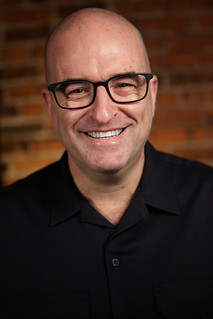 About the Interviewer
About the Interviewer
Greg Bennick (www.gregbennick.com) is a keynote speaker and long time coin collector with a focus on major mint error coins. Have ideas for other interviewees? Contact him anytime on the web or via instagram @minterrors.
To watch the complete video, see:
Stanley Kesselman Interviewed for the NNP by Greg Bennick
(https://nnp.wustl.edu/library/book/638521)
To read the complete transcript, see:
Stanley Kesselman Interviewed for the NNP by Greg Bennick (Transcript)
(https://nnp.wustl.edu/library/book/638520)
To read the earlier E-Sylum article, see:
STANLEY KESSELMAN INTERVIEW, PART ONE
(https://www.coinbooks.org/v27/esylum_v27n25a06.html)
STANLEY KESSELMAN INTERVIEW, PART TWO
(https://www.coinbooks.org/v27/esylum_v27n26a13.html)
STANLEY KESSELMAN INTERVIEW, PART THREE
(https://www.coinbooks.org/v27/esylum_v27n27a11.html)
STANLEY KESSELMAN INTERVIEW, PART FOUR
(https://www.coinbooks.org/v27/esylum_v27n28a17.html)
ERIC SCHENA INTERVIEW, PART TWO
Greg Bennick also interviewed exonumia researcher and collector Eric Schena. Here's the second part, where Eric talks about tokens and their important connection to local history. -Editor
GREG BENNICK: That's incredible. I mean truly incredible. There was a few years ago maybe ten years ago I used to go out on the road and do these. I still speak professionally, but I would go out on the road and do these spoken word tours. And there was one night where I had off. I was on a tour in the, in the West, in the West, in Utah. The guy who was booking me was like, "Well you've got this night off" and I said, "Well I want to do something unusual. "So, I actually made an announcement that I was going to be speaking in an abandoned gold mining town, and that anyone interested from Salt Lake City who was interested in hearing me speak in an abandoned gold mining town could come drive three hours into the basically into the wild and come to this abandoned gold mining town.
And we set up in this abandoned literally abandoned, used to be a town, here area where there was just some mining equipment and some smelting equipment remaining. We set up a campfire, and there was about six or seven people who showed up, and it was half camping, half me doing my spoken presentation about legacy and whatnot and the things I was speaking on that that applied to that particular night. We put up a sign that announced that any of the ghosts of this old mining town who wanted to come to see this event, that they could come for free, and it was pretty remarkable. I did this presentation in the middle of this town.
And the reason I bring it up is because it speaks exactly to what you were talking about, that nothing was there of that town. And if you saw it, it was just residue of, you know, "industry" and people living there. But realistically, without bringing something to it, without your research, without the token that you identify as being from that town. The town would be gone without the spoken word show, the token, the research, the piece of scrip, whatever it is that you might have. So, it's pretty fascinating the way that we can keep history alive in a way quite literally through our hobby or through our actions or through our research, our interest.
 ERIC SCHENA: Yep, I absolutely agree. If I may ask, what was the town that you were speaking?
ERIC SCHENA: Yep, I absolutely agree. If I may ask, what was the town that you were speaking?
GREG BENNICK: I knew you were going to ask me and the second, I'm going to look it up while we're talking. Okay, I got it. It was Frisco, Utah, and I know nothing about it.
ERIC SCHENA: Frisco, Utah, I have heard of it.
GREG BENNICK: Really?
ERIC SCHENA: I have heard of it because it is known as one of the most dangerous wild towns in the West.
GREG BENNICK: That's right.
ERIC SCHENA: Yeah, and I actually have a token from Frisco.
GREG BENNICK: No way.
ERIC SCHENA: Yeah,
GREG BENNICK: I just got goosebumps for the first time in any Newman Numismatic Portal interview. That's amazing. Let me know if you ever encounter another token from Frisco but please tell us about…do you remember anything about the token from Frisco that you might have.
ERIC SCHENA: No, I don't. There's not an awful lot of information on this particular merchant. It does have a little bit of disputed attribution. Let's see if I can lay my hands on it.
GREG BENNICK: And while you do, I'll explain to people that you're absolutely right. That that's all I know about Frisco, Utah, is that it was this lawless place filled with gambling and murder and all sorts of things. And all that's left now as you drive up to it is some smelters, a whole bunch of mining equipment. I could probably put some photos in the video part of this interview of it. There's mining equipment, there's piles of rubble and the legacy of my spoken word show, which was the first live event in Frisco, Utah, in over a hundred years.
ERIC SCHENA: If memory serves me correctly, Frisco had a silver mine called the Horn Silver Mine. It was a huge mine. It was an underground working. I think this is the right town that I'm remembering. It collapsed and there were a massive number of deaths at that mine. I would have to do some research on that a little bit more, but the town did bounce back a little bit. But yeah, it's one of those Western ghost towns. I like Western ghost towns too. I have a very small collection of store tokens from the West. I briefly lived in Southern California, at Edwards Air Force Base and around there, there were two types of mines, gold mines and borax mines. The world's largest borax open pit was just north of the base and a place called appropriately named Boron and I remember as a kid, first off getting into rock hounding while I was out there and two, going to that open pit mine at the time it was called the U.S. Borax Mine. It's now owned by Rio Tinto, if I remember correctly, and it's just this enormous - you've never seen a hole that big - enormous hole in the ground, trying to dig all these minerals out.
And we, we learned a little bit about California's wild west history while we were living there, but I never really got into it until later when I started collecting tokens. Getting that piece of history, having a physical piece of history and being able to place it in a specific town… Like for instance, having a saloon token from Frisco or from any of those other places or Rhyolite, Nevada, or, I wish, Bodie, California, Bodie is one of the most famous of the of the ghost towns. And there are tokens known from Bodie and they fetch appropriate prices. They're not cheap. I don't have one. I wish I did! I've always liked that kind of thing.
So, I've kind of adopted that here since moving to Virginia in 1984. I still collect things…I mean…this is from Utah. This is panic scrip from a gold mine and abandoned town in gold in Kimberly. Now the scrip is usually listed under Richfield, Utah, but that was because that was the nearest banking town, the actual town where this was used was a hundred miles away in a place called Kimberly, way up high in the mountains, and there's nothing there now. Things like this, that's the history. And I consider myself a steward of that history. That is especially important with Western gold mines and non-gold, non-precious metal mines - what they would call hard rock mines versus coal mines, which is the primary mining around here. Two hours due west of where I live are the Upper Potomac coal fields. And there are an awful lot of scrip from those mines. Western Maryland has quite a few and bleeds a little into Pennsylvania, but Pennsylvania has a different type of coal. Pennsylvania is primarily anthracite. West Virginia is mostly bituminous.
GREG BENNICK: Tell us the difference because I've got family from Pennsylvania and I feel ignorant and a little silly in the moment that I can't remember the difference. But please, for the viewers…
ERIC SCHENA: There is a difference. One has a higher sulfur content than the other. I believe anthracite burns cleaner, but bituminous is more common now lignite, which is also found in certain places in Western Virginia, that burns very dirty. And in fact, there was a there was a town called Lignite in a place called Botetourt County, Virginia. It is a ghost town is what an archeologist would call an ankle bone site. That means the the remains don't go any higher than your ankle. So that's a term that I learned in college when - my degree is in Greek and Roman archeology of all things.
GREG BENNICK: Meaning that everything is is leveled to the level….
ERIC SCHENA: Yeah. That there's no structure higher than your ankle bone. So, we'll sometimes call them ankle bone sites. Lignite is entirely in the Jefferson National Forest now. And there are tokens from there and I do in fact have one but that's all our remains of that town.
GREG BENNICK: And I love what you said about being steward, a steward of the history. Right. And I mean, and not to bring it back to this Frisco, Utah experience, but we felt like we felt that night, like we were doing something and I'm putting this in air quotes "important", meaning that what we were doing wasn't important to anybody else, but historically we were remembering something and thus making it real again. And you're doing the same thing when you hold up a piece of currency from a town, a hundred miles from a bank that doesn't exist anymore. You're the one talking about that place today and keeping it alive and keeping it real.
ERIC SCHENA: Yeah, exactly! And that's how I feel about it. And that's one of the reasons why, with the second edition of Dave's token book, I wanted to include pictures of some of these towns and some of these stores and some of the ephemera that goes with it. If you ever get a copy of the book, there are pieces of bill head and some checks, things like that, which tell that story. It gives a little bit more of a face to these objects. I mean, they're inanimate objects, but there's a story behind them and I want to tell that story. In the town that I used to live in, here in Virginia, there was a general store, maybe about two and a half miles away from my house. It was the general store. It was the grist mill. And it was also the post office for the town. The place was called Whitacre. It's still there.
The store building is still there though, it is abandoned unfortunately. I don't think the mill building is still there, but there were some cardboard tokens that were issued there. The great thing about them is they had to be signed. W.C. Whitacre was the first person who owned that store and then he passed it off to his sons. And one of them was named Landon and you'll see Landon Whitacre written on some of these tokens. And the funny thing about those is they all came from a batch that Dave himself got when he and his wife Joanne were going around the state of Virginia, collecting tokens and preparing for the book. He actually went to Whitacre and was inquiring about that general store.
It was still open at the time and I happen to know that it was owned by a man by the name of Dolan. But that family lived right across the street from the store and they invited him over. They had some sweet tea and he was asking about the tokens and they brought out a little jar of them and he picked out a bunch. And so that's where a big chunk of them came from. And that's the kind of story that I love to hear, because those people are no longer there. I don't know who owns that store building anymore and who knows what's going to happen to it in the future. It could end up like that store in Rileyville: bulldozed for a parking lot. So that's why it's important to preserve that history.
 About the Interviewer
About the Interviewer
Greg Bennick (www.gregbennick.com) is a keynote speaker and long time coin collector with a focus on major mint error coins. Have ideas for other interviewees? Contact him anytime on the web or via instagram @minterrors.
To watch the complete video, see:
Eric Schena Interviewed for the NNP by Greg Bennick
(https://nnp.wustl.edu/library/book/639081)
To read the complete transcript, see:
Eric Schena Interviewed for the NNP by Greg Bennick (Transcript)
(https://nnp.wustl.edu/library/book/639095)
To read the earlier E-Sylum article, see:
ERIC SCHENA INTERVIEW, PART ONE
(https://www.coinbooks.org/v27/esylum_v27n28a18.html)
STACK'S BOWERS OPENS COPENHAGEN OFFICE
With this press release, Stack's Bowers Galleries announces the opening of their new office in Copenhagen, Denmark. -Editor
Stack's Bowers Galleries is pleased to announce the opening of its newest office centrally located in the heart of Copenhagen, Denmark. As one of the world's leading rare coin and currency dealers and auctioneers, the firm is thrilled to extend their global presence to better serve its European bidder and consignor clientele. Beginning in July, Stack's Bowers Galleries will provide world-renowned expertise and manage their upcoming sales of the L. E. Bruun Collection, the world's finest private collection of Scandinavian coinage and the world's most valuable collection of international coins ever to be sold, from this new location.
The "grand old man" of Danish professional numismatics, Michael Fornitz will lead Stack's Bowers Galleries' team of expert numismatists. A native Copenhagener, Fornitz, who holds a M.A. in numismatics, has 40 years of experience in the auction field and has been head of the numismatic department in three Scandinavian auction houses. Through the years Fornitz has cataloged most major Danish single-owner sales of Danish, World and Ancient coins and has orchestrated the most world price records for Danish coins. For the last 20 years he has worked as deputy director and chief numismatist at Bruun Rasmussen Auctioneers, a Bonhams' affiliated firm.
He will be joined by Henrik Berndt, who offers more than 15 years of diverse experience acquired in the numismatic departments of prominent auction houses such as Bruun Rasmussen and Spink, London. Most recently, Berndt has single-handedly built a strong and highly respected numismatic auction business at Danish auction house VF Auktion. A true collector in many areas, Berndt loves the coin business as well as the intelligent and dedicated collectors and colleagues one finds in the world of collectibles.
Rounding out the team is Peter Bjørnstrup who will serve as a consultant and brings 25 years of experience as a senior auction cataloger, private dealer and numismatic author and publisher. Bjørnstrup spent several years leading the coin department at Thomas Høiland Auktioner before purchasing his own coin and stamp shop in Roskilde, Denmark, which he operated for more than 15 years. Bjørnstrup was bitten by the collecting bug when he received his first cigar box of coins from a family friend in 1967. As an adult he decided to make numismatics his career and has loved every minute of it.
"We are thrilled to announce our strategic expansion to service our European clientele and support our multi-year offerings of the L. E. Bruun collection. Establishing our presence in the heart of central Copenhagen marks a significant milestone for our company and enables us to offer our full suite of services to the European market, including accepting auction consignments and providing appraisals" said Stack's Bowers Galleries President Brian Kendrella. "As is customary for Stack's Bowers Galleries, we have assembled a team of elite numismatic specialists to serve our clients, ensuring that they receive the highest level of expertise and personalized service. I am honored to welcome Michael, Henrik, and Peter to our team."
"Being able to combine working for the oldest and most revered American numismatic company, with cataloging the world's most valuable international coin collection ever to be sold at auction, is no less than a personal dream come true. Together with my team, I look very much forward to welcoming numismatists from all around the globe to wonderful Copenhagen," said Stack's Bowers Galleries Denmark's Director Michael Fornitz.
The Copenhagen office can be reached by telephone at +011.45.88749409 (local number) or +011.45.80404942 (toll free) or by email at infoDK@StacksBowers.com.
NUMISMAGRAM MEDAL SELECTIONS: JULY 21, 2024
Numismagram's Jeremy Bostwick sent along these five medals from his most recent upload of new material to his site. For all of the new items, please visit https://www.numismagram.com/inventory. -Editor
102701 | AUSTRIA. Holy Roman Empire. Marriage of Joseph II to Maria Josepha silver Medal. Issued 1765 (39mm, 26.16 g, 12h). By A. Widemann. IOSEPH • II • R • REX S • A • M IOSEPHA BAV • CAROLI VII • FILIA, draped busts right of Joseph, laureate and armored, and Josepha // AVSPICIA FELICITATIS PVBL•, Austria, holding baton, and winged Genius, holding torch and wreath, standing around altar bearing coats-of-arms of Austria and Bavaria; in two lines in exergue, VOTA SECVNDA MDCCLXV / XXIII IAN. Edge: Plain. Montenuovo 1938; Wittelsbach 2249. PCGS SP-63. Mostly gunmetal gray toning, with intense iridescence around the devices and a great lustrous brilliance in the fields. No doubt one of the most attractive examples of the type extant, and the sole representative in the PCGS census. $595.
To read the complete item description, see:
102701 | AUSTRIA. Holy Roman Empire. Royal Marriage silver Medal.
(https://www.numismagram.com/product-page/102701)
102832 | UNITED STATES. Philadelphia. Cathedral of St. Peter & St. Paul silvered white metal Medal. Issued 1864 (79mm, 223.56 g, 12h). By A. Paquet. CATHEDRAL OF ST. PETER AND ST. PAUL, PHILADELPHIA, frontal view of the cathedral; in two lines in exergue, BEGUN 1846 / COMPLETED 1864 // TU ES PETRUS ET SUPER HANC PETRAM AEDIFICABO ECCLESIAM MEAM / VAS ELECTIONIS EST MIHI ISTE UT PORTET NOMEN MEUM CORAM GENTIBUS, perspective interior view, from a vantage point just left of center. Edge: Plain. Eidlitz 1129. Choice Mint State. Later silvering and engraving in 1890, as is fairly customary for the type; alluring matte surfaces. Includes original case of issue. Previously housed in an NGC Details holder on account of the "altered surfaces." Nevertheless, NGC has straight-graded other examples with such silvering and later engraving, so their tougher stance in this instance merely points to their wild inconsistencies. Compare to these such straight-graded examples, which have had identical post-mint alterations. [https://archive.stacksbowers.com/?q=3c5a3c96-696b-43e4-b5bd-311c5084a458] A very rare and extremely popular type. Ex: Bowers & Merena (September 1985), lot 3208. $1,095.
To read the complete item description, see:
102832 | UNITED STATES. Cathedral of St. Peter & St. Paul silvered WM Medal.
(https://www.numismagram.com/product-page/102832)
102640 | GERMANY. Halley's Comet silver Medal. Issued 1910. Commemorating the famous periodic comet (44mm, 29.84 g, 12h). By K. Goetz at the München mint. JEDE WOLKE–SO SCHWARZ SIE DROHT–DEM HIMMEL ZUGEWANDT= / DOCH IHRE LICHTE SONNENSEITE HAT (each cloud as black as it may threaten, has its light side which is turned towards the sun) / KOMET HALLEY, facing personification of the sun, with smaller sun faces surrounding; below, the comet traveling toward the sun // The constellations Orion and Canis Major pursuing that of Lepus to right; above, the constellations Serpens and Cetus, through which the comet passes; the twelve signs of the zodiac around. Edge: Plain. Kienast 71. PCGS MS-62. Extremely mirrored and prooflike, with some subtle toning at the peripheries and elegant frosting upon the devices. Somewhat conservatively assessed in the opinion of this cataloger. A fairly scarce and interesting non-satirical type from the hand of Goetz, far more difficult to encounter than the bronze version. The only such example in silver observed in the PCGS census. $1,985.
To read the complete item description, see:
102640 | GERMANY. Halley's Comet silver Medal.
(https://www.numismagram.com/product-page/102640)
102790 | UNITED STATES & GERMANY. Woodrow Wilson cast bronze Medal. Issued 1916. "Wilson im Weltkrieg als eifriger Notenschreiber" (Wilson in the World War, the Diligent Writer of Notes) (73mm, 122.99 g, 12h). By H. Lindl in Berlin. OHNE FLEISS KEINEN PREIS (without diligence, no reward), Wilson seated facing slightly left at table, writing memorandum and clasping bag of money; in three lines in exergue, WILSON IM WELTKRIEG / ALS EIFRIGER NOTEN / SCHREIBER (Wilson in the world war, the diligent writer of notes) // NEUTRALITÄT U GERECHTIGKEIT (neutrality and justice), nude female figure of Justice, blindfolded, holding pair of scales in which sit a German eagle and a British bulldog; behind, Death (as a skeleton), guiding her and tipping the scales in favor of Great Britain. Edge: Plain. Klose –; Art of Devastation p. 279, 74 (AoD 7513.12914.3.a); Jones, Dance of Death, 36; Frankenhuis 1458. Choice Mint State. Charming brown surfaces, with some lighter hints upon the higher points. Very rare. Ex David Nicholas Silich Collection. Ex Baldwin's 90 (24 September 2014), lot 2127. $695.
To read the complete item description, see:
102790 | UNITED STATES & GERMANY. Woodrow Wilson cast bronze Medal.
(https://www.numismagram.com/product-page/102790)
102786 | GREAT BRITAIN & UKRAINE. Sellafield and Chernobyl silver Medal. Issued 1986. Fallout (30mm, 25.56 g, 3h). By M. Appleby. Representations of flora and fauna (tree, fish, and goat) affected by the impact of nuclear fallout and other airborne environmental disasters; all within vertical 'cat eye' border // FALLOUT / 1986 around horizontal 'cat eye' border. Edge: Multiple hallmarks and 32. The Medal 10 (Winter 1986), p. 74; Attwood 37 & pp. 28-29. Essentially as Made. Highly lustrous and tactile, with some attractive iridescent toning. A powerful and rare piece, 1 of just 39 hand struck by the artist from hand engraved dies (serial number 32). $395.
To read the complete item description, see:
102786 | GREAT BRITAIN & UKRAINE. "Fallout" silver Medal.
(https://www.numismagram.com/product-page/102786)
STACK'S BOWERS OFFERS COLOMBIA PAPER MONEY
Stack's Bowers Director of Consignments & Senior Numismatist Dennis Hengeveld published this article about paper money of Colombia in the firm's August 2024 sale. -Editor
As the finishing touches are put on the August 2024 Global Showcase Auction of World Paper Money (to take place the week of August 12, with the premier world paper money session on that day) there is a special collection worth highlighting. The Gran Colombia Collection of Colombian paper money includes select rarities from this South American nation, including notes not previously offered by us, despite having handled some of the most advanced South American collections ever assembled. Some of the rarities from the Gran Colombia Collection are listed below, but there are many others, so be sure to watch our website for the entire catalog, to be posted shortly.
Lot 30197 is the finest known example of the overprinted El Banco de Bogota 50 Pesos, graded About Uncirculated 53 by PMG. This note was issued as part of the provisional Banco Nacional series in 1899. As a cost saving measure and to save time, old stock of private banknotes were overprinted on the back and released into circulation. Many were remainders dating back several decades. It created a fantastic series of banknotes, many of which are the only way to acquire some of these earlier types, which are not known in their original form.
Another example of this provisional series is lot 30200. Overprinted on a circa 1877 issue of the Banco Popular, this 5 Pesos is graded Very Fine 30 by PMG. The host note is particularly interesting for its central vignette, a scene that first appeared in the book "Ballads of Bravery" by George Melville. It was first published in 1877, meaning that the designer of the note decided to copy it relatively quickly for the banknote. The host note was printed in Bogota, Colombia. Perhaps it was an early example of copyright infringement? We'll never know, but it certainly made for a unique design on the note.
Moving on from the provisional 1899 series we take a step back in time to the 1880s, and a quartet of notes from the Banco de la República offered in lots 30205 to 30208. This series, produced by the American Bank Note Company of New York, is particularly interesting as the portrait of George Washington appears on three of the four notes offered. The presence of the first President of the United States of America is perhaps a bit odd, but at the time there was a sense of Pan-American unity throughout the Americas. In addition, Simon Bolivar had seen Washington as an inspiration, so many older Colombians were familiar with him. Even today there is a statue of George Washington in a small park in Bogotá.
Lots 30214 and 30215 are an interesting and extremely rare pair of railroad issues dating from around the turn of the 20th century. At the time, Colombia was trying to establish its railroad system (with varying rates of success) and the companies put out bonds and banknotes to finance the construction of their respective lines. Typically, these were redeemable after a certain amount of time or after a section of the railroad was completed. Not surprisingly, these Ferrocarril issues are highly collectible, and many are rare. Both examples offered in these lots are from issuers that we have not previously offered.
The final lot of the Gran Colombia Collection we will discuss in this blog (although we could highlight at least a dozen other notes, so make sure to take a look at the entire catalog) is lot 30217. It is a proof for a 50 Pesos of the Credito Maritimo, dated 1886 and graded About Uncirculated 50 by PMG. Very little is known about this note or its issuer. It is unlisted in the Pick catalog. Few proofs are known, which appear to have been produced by "LIT. ROBES, AGLA 3 y 5 BARCELONA", at least according to the imprint on the bottom of the note. An exceptional rarity that will no doubt be a welcome addition to whatever advanced collection of Colombian paper money it next enters.
To read the complete article, see:
PRESENTING THE GRAN COLOMBIA COLLECTION OF PAPER MONEY
(https://stacksbowers.com/presenting-the-gran-colombia-collection-of-paper-money/)
HERITAGE ANA WORLD & ANCIENT SELECTIONS
Here are a number of selected items in the Heritage sales associated with the upcoming American Numismatic Association show. -Editor
A 2008 Nobel Prize in Physiology or Medicine, which was awarded in 2008 to virologist Harald zur Hausen, will be among the top attractions in Heritage's ANA World & Ancient Coins Platinum Session and Signature® Auction August 15-17.
zur Hausen received the award for his research that led to the isolation of human papillomavirus (HPV) DNA from cervical cancer cells.
"The scientific and medicinal significance of his research, and the benefits afforded to countless women over the years can not be overstated," says Cris Bierrenbach, Executive Vice President of Internationa Numismatics at Heritage Auctions. "He conducted his research in the face of considerable skepticism from within the scientific community, but his determination led to irrefutable evidence of the connection between HPV and cervical cancer. His research also fueled a broader investigation into the role of viruses in other types of cancer, leading to the identification of viral links to liver cancer and various lymphomas, as well as advancements in molecular biology techniques.
"The winning bidder will be acquiring an enduring symbol of immeasurably important scientific research."
The auction also features a trio of notable collections, including the James D. Wolfensohn Collection of Australian Sovereigns, a 262-lot assemblage that is one of the finest troves of Australian gold ever assembled.
Among the top lots from the collection is a stunning George V gold Sovereign 1920-S MS63 PCGS, which is one of the rarest circulation-strike sovereigns from anywhere in the British Commonwealth, and the rarest from Australia. This date and mint pairing is so rare that it has earned the title of "King of Australia's Sovereigns" and was hailed in the Quartermaster catalog as "Australia's rarest circulating Sovereign."
Also from the Wolfensohn Collection is an exceptionally rare South Australia. British Colony gold "Adelaide" Pound 1852 AU55 PCGS. The Type 1 Adelaide Pound is significantly scarcer among the two reverse types, with most surviving examples being of the crenulated variety-a design element introduced to new dies after the noted obverse die crack. This alteration occurred early in the production of these emergency Adelaide Assay Office issues, explaining the large disparity in surviving specimens. Of the total recorded montage of 24,648, it is estimated that fewer than 50 were produced with Type 1 reverse die — a total that also is reflected in the current certified populations, in which Type 2 outnumbers Type 1 with a ratio of 10-to-1. At PCGS only three Type 1B "coarse reeding" examples, like the one offered here, are witnessed, compared to six Type 1A "fine reeding" pieces.
Other selections from the Wolfensohn Collection include, but are not limited to:
- A Victoria gold 1/2 Sovereign 1856-SYDNEY MS62 PCGS that is tied for the highest-graded example at PCGS
- A Victoria gold 1/2 Sovereign 1855-SYDNEY XF45 PCGS
- A George V gold Sovereign 1923-S MS64 PCGS that is tied for the highest-graded example
- A South Australia. British Colony gold "Adelaide" Pound 1852 MS63 PCGS
- A George V gold Sovereign 1926-S MS64 PCGS
Another prominent collection in the auction is the Carpathian Collection of Romanian Coins, which is one of the finest troves of coins from the European nation ever assembled.
Among the highlights in the collection is a Carol I gold Specimen Pattern 20 Lei 1868 SP63 Deep Cameo PCGS, a choice rarity in the series, one of the most celebrated in all of Romanian numismatics and the finest piece known at either major grading service. A lesser example sold at Heritage's NYCINC auction in January for $336,000. Only 100 were minted, but it is believed that far fewer survive today, with those in major collections and museums typically faring as "circulated." The example offered in this auction is believed to be the finest known example.
Also from the collection comes a Carol II gold "Angel over Arms" 100 Lei 1939 UNC Details (Rim Filing, Cleaned) NGC. Struck in celebration of the centennial of the birth of Carol I, this magnificent coin is a behemoth within the greater Romanian series and one that is pursued eagerly regardless of conditional assignment, because so few are ever available. It can be found more frequently as a Pattern, but this auction marks just the second time Heritage has offered an example in gold — the first being the Paramount specimen in 2021. Despite sharing a mintage with its "large arms" counterpart, examples of the "angel over arms" type appear at auction almost half as often. The example offered in this auction is one of just three certified by NGC.
Other top attractions from the collection include, but are not limited to:
- A Carol II gold "Jubilee" 100 Lei 1940 UNC Details (Repaired) NGC
- A Carol I 2 Lei 1901 MS63 PCGS
- A Carol II gold "Jubilee" 100 Lei 1940 AU55 PCGS
A third prominent collection in the auction is the Otoh Collection of Physical Cryptocurrency, Part II. Heritage Auctions made numismatic collectibles history in November when The Otoh Collection of Physical Cryptocurrency, Part I Platinum Session Signature® Auction totaled $7,198,200. The Otoh — or "On The Other Hand" — Collection, named after the online handle of the consignor, is the most significant offering of physical cryptocurrency ever brought to auction. Currency, whether coins or paper, historically has been a tactile entity, something that can be touched, held and carried and then exchanged for goods and services. However, the value of digital currencies is dematerialized into units of coded data, or "bits." Bitcoin, which was founded by an anonymous person (or persons) in 2009, enjoys preeminent stature among digital currencies.
"Part of the appeal in cryptocurrency," Bierrenbach says, "is that digital currency can be received, stored and sent without intermediaries, affording the owner a previously non-existent measure of financial control.
"Otoh is one of the early adopters of physical Bitcoin, and his thoughtful approach and analysis of cryptocurrency trends is reflected in this extraordinary collection."
Among the top lots in Part II of the collection are:
- A Casascius brass Unloaded ("Demo") 1 Bitcoin (BTC) 2011 MS64 PCGS
- A Lealana silver Loaded (Unredeemed) "King Kam - Gilt Body/Frosted" 1 Bitcoin (BTC) 2016 MS70 NGC
- A Casascius gold-plated brass "Storage Bar" Bearer Bar Loaded (Unredeemed) 3 Bitcoin (BTC) 2011 Genuine PCGS
- A Casascius acrylic Unloaded (Unfunded) 1 Litecoin (LTC) ND (2011) Genuine NGC
The auction includes an exceptional array of British coins, including the finest Anne gold 5 Guineas 1709 MS61 PCGS graded by PCGS. It is among the scarcest post-union issues to locate at auction, especially at this advanced tier of preservation. The example offered in this is just the fourth to come through Heritage Auctions; the best of the first three an AU58+ that brought $132,000 at Heritage's ANA auction last year. Any Mint State offering from this series, like the offered example, is a conditional outlier and is the finest entry at PCGS, and only two representatives submitted higher to NGC.
Also in play is a George IV gold Proof 5 Pounds 1826 PR63+ Deep Cameo PCGS that is the largest inclusion in George IV's mid-reign Proof set. Among the earliest creations by Britain's most famous engraver, William Wyon, the offered example is the finer of just two offered through Heritage Auctions.
Ancient coins
The Maximinus I (AD 235-238). AV aureus (21mm, 6.56 gm, 7h). NGC Choice XFstar 5/5 - 3/5, brushed offered in this auction is extremely rare. It is just the fifth example to come to market in the last two decades, and the only one graded by NGC.
An ANTIQUITIES. Roman Imperial. Severus Alexander (AD 222-235). AV aureus (19mm, 11h) in contemporary gold setting and chain. Choice XF holds enormous crossover appeal, with a Severus Alexander aureus pendant with an openwork border of leaf pattern and a ribbed suspension that is attached to a knitted herringbone chain. It is believed that necklaces that contained coins, like this one, were worn to serve as a form of protection with both apotropaic (to ward off evil) and prophylactic (to ward off sickness) purposes, as it established a connection to the emperor, and also was a way to show support for the emperor; since the beginning of the Roman Empire, imperial cults were formed to worship the emperors as gods as a direct result of the deification of Julius Caesar.
A Vespasian (AD 69-79). AV aureus (19mm, 7.40 gm, 6h). NGC MS 5/5 - 2/5, brushed is an extraordinary example of an important coin from the Judaea Capta series, which was created after the Roman Empire's victory in the Jewish-Roman War to celebrate Rome's conquest of Judea. Issued under Emperors Vespasian, Titus and Domitian, these coins served as powerful propaganda tools, reinforcing Rome's authority and Vespasian's role in securing peace and stability for the empire.
Another fascinating offering in the auction is a Rare and Complete Aes Signatum Currency Bar that is exceedingly rare; just two other examples are shown in literature — one in a British museum and another in a museum in Naples.
A SICILY. Siculo-Punic. Ca. 264-260 BC. AR 5-shekels or decadrachm (41mm, 37.91 gm, 12h). NGC XF 5/5 - 3/5, Fine Style was struck during the First Punic War with Rome (264-241 BC) and was of the earliest phase, being on the Punic instead of the Attic standard. Jenkins translated the Punic as meaning "in the land," perhaps a statement by the Carthaginians that they were the rightful occupants of Sicily, instead of the newly arrived Romans.
To view all the lots in this auction, see:
https://coins.ha.com/c/search/results.zx?term=&dept=1909&auction_name=3118&mode=live
WAYNE'S NUMISMATIC DIARY: JULY 21, 2024
 I was still recovering from jet lag following our Switzerland trip, but after work on Tuesday July 16, 2024 I pointed my car to Ozzie's Good Eats in Fairfax for the latest dinner meeting of my numismatic social group, Nummis Nova. Our host Mike Packard chose the venue, a bustling traditional style Italian bar-restaurant with classic leather booths, floor tiles and a tin ceiling.
I was still recovering from jet lag following our Switzerland trip, but after work on Tuesday July 16, 2024 I pointed my car to Ozzie's Good Eats in Fairfax for the latest dinner meeting of my numismatic social group, Nummis Nova. Our host Mike Packard chose the venue, a bustling traditional style Italian bar-restaurant with classic leather booths, floor tiles and a tin ceiling.
I arrived early on a stifling hot evening of 101 degrees, and learned regular Tom Kays had to cancel, having lost the air conditioning in his car. I found Dave Schenkman and Eric Schena already waiting at the cool bar, and I sat down and ordered a beer. I showed off some photos of our trip and the Taylor Swift concert.
After a bit we walked over to the host stand, and Mike Packard was waiting there, along with Tom's guest Dave Ellison of the Fairfax Coin Club. As we took seats at our table we were soon joined by Mike Markowitz, Steve Bishop, Lorne LaVertu and Julian Leidman. Julian's guest was Erik Douglas, who has taken over the operation of Julian's Bonanza Coins
The above image is an OpenTable view. Here are a couple photos I took at the end of the evening.
The restaurant split us up into two tables, which made conversation more fragmented. But there were some great numismatic items being passed around the tables. But first, here are a couple photos taken by Mike Markowitz.
Steve's Beauties
Steve Bishop starts us off with some U.S. type coins. The proof Liberty Seated Half was particularly nice. Beautiful coins.
Dave's Delights
Dave Schenkman often digs into his collections to bring along some very rare and interesting items. Here's a great U.S. Mint medal.
Dave writes:
"It was struck by the mint and listed in R. W. Julian's Medals of the United States Mint as AM32. Julian gives 28mm as the size, but this one is 26.4mm.The reverse inscription is "To / E. Harris / Woonsocket R.I. / For / Double Twist & Sideband / Doeskin Cassimere. / A. Murdoch & Co. Agts. / 1858"
Dave reported finding this one in a dealer's stock for sale at the price of the gold bullion. What a great find! Beautiful piece.
Dave writes:
"I was only aware of this 1860 John C. Breckenridge political medalet's existence because of its listing in J. Doyle DewWitt's A Century of Campaign Buttons 1789-1889, but had never seen an example until this one was offered by Stacks Bowers in one of their sales of John Ford's collection; I purchased it, and have never seen another example.
"DeWitt catalogs the piece, which is 25mm and has a reeded edge, as JCB 1860-3, and lists strikings in brass, copper, silver, and white metal in addition to this one, which he calls "German Silver with Copper or Brass Center." The center of my medalet is copper. DeWitt cites Satterlee for the attribution of M. H. Miller & Co. of Louisville as the die sinker.
"I can't imagine why the piece was struck. I've found no records of other bimetallic medals from the era. The silver pieces were undoubtedly produced for collectors, and possibly some well-heeled numismatist commissioned Miller to strike this one."
Another great piece - I'd never seen this one before.
Grant/Colfax Election 1868 Campaign Medal
An item brought by Julian Leidman was identified by Dave Schenkman.
Dave writes:
"The piece is struck in silver and is 32mm. It is listed in DeWitt as USG 1868-13, but not illustrated. DeWitt added "I have not seen this piece which appeared at No. 3806 in the Henry W. Holland sale in 1878."
To read the complete lot description, see:
Grant/Colfax Election 1868 Campaign HR Medal EX RARE PF DeWitt# USG 1868-13
(https://www.ebay.com/itm/204895651565)
Depression Scrip
Eric bought two great pieces of Depression scrip I'd never seen before.
Eric writes:
"I brought some examples of Depression scrip that I recently acquired. The more impressive looking piece is a $1 note issued by the Santa Cruz (CA) Chamber of Commerce that was used to pay unemployed workers for public works projects. They would be paid in these trade warrants, then go to participating businesses to spend. To redeem them, the warrant needed 50x2¢ stamps affixed to it each time the note was used - it could only be redeemed for US currency when all 50 stamps were obtained. The other note is a scarce note from the City of Lewiston, Maine. I have only seen one other a few years back and always thought the rich green printing was neat and attractive."
I collected Depression scrip for a time, and greatly enjoyed the types like the Santa Cruz piece where each spender has to sign or affix a stamp. There are great artifacts of financial history. But I'd never seen one as large as this! Both great pieces.
New Book: Damaged Pocket Change
Before wrapping up, here are a couple more items that came my way this week. Saw this one on Facebook. Doesn't exist, but maybe it should.
To read the complete post, see:
https://www.facebook.com/photo/?fbid=706199536654783&set=a.257827851491956
To read the earlier E-Sylum article, see:
RED BOOK IMPROVEMENTS TARGET MISINFORMATION
(https://www.coinbooks.org/v27/esylum_v27n28a08.html)
Wayne's $500 Bill
Wayne Pearson writes:
"In appreciation for you running my ideas, from time to time, I made this for you."
Thanks!
A PROGRESSION OF FISCAL PAPER
Tom Kays was unable to attend this week's Nummis Nova dinner, but he kindly sent along this great write-up on U.S. checks and fiscal paper. Thank you! -Editor
In July, Nummis Nova folks met at Ozzie's Good Eats, an Italian Restaurant in Fairfax. On that Tuesday evening the actual air temperature hit 100 degrees, with a heat index somewhere near the "hades-on-a-hot-plate" comfort level. With no vehicle air conditioning, Tom bowed out from driving, missing in-person dining at the last minute; yet now brings you some "would-be show-and-shares," just as if they were passed around the table that night. My theme was "A Progression of Fiscal Paper."
Collecting "ephemera" meaning "short-lived items" and to a numismatist includes old fiscal paper which give fascinating glimpses into the fragments of everyday life from long ago. According to the Ephemera Society of America Website: Ephemera is a vast and diverse field of collecting that is hard to define, of things or stuff originally produced for an immediate, practical purpose with no thought that it would be saved or preserved.
Passing through a small town in Virginia I found a stack of old documents in a dusty antique store and was amazed at how informal early banking could be.
One Thousand Dollar Draft drawn on the Farmers & Mechanics Bank in Georgetown, (founded by George Corbin Washington and Romulus Riggs in 1814) in Washington D.C. of July 31, 1856.
Here is just a scrap of lined note paper that served as a one-thousand-dollar bill, payable to D. G. & Co. or bearer to be drawn from John Dickson's account. It has no security features other than a signature. Another scrap of paper torn from a school notebook served as a check in old Georgetown.
Georgetown Farmer's & Mechanic's Bank (Washington D.C.) check for $157.81 from January 6, 1859 endorsed by a signature on the back.
Upscale banks and those that stayed in business for more than a few months would issue pre-printed checks on stationary as a simple means of verification and authenticity of the document.
Union Bank Draft from Boston on Oct 16, 1858 for $44.80 printed by C. K. Darling, Stationer, 20 State Street
Ilion Bank of Herkimer, New York - Check for $51.22 of April 2, 1853.
Fancier banks employed steel engravings on their pre-printed fiscal paper making it harder to forge documents. Well established banks had the time and money to make a good show of their respectability by ordering fine steel engraved vignettes from specialty bank note printing houses.
Merchants Bank of Burlington, Vermont $395.87 Check of June 20, 1865 with pastoral sheep and duty paid by George Washington U. S. Internal Revenue two-cent stamp with hand-written ink cancellation.
U. S. Revenue stamps in denominations from one cent to two hundred dollars were issued during the Civil War starting in 1862, to help fund the war by payment of duties on "proprietary" items like playing cards, patent medicines, alcohol, tobacco, cotton and even photographs, or "documentary" items such as bank checks, bonds, leases, life insurance policies, mortgages, probate of wills, and surety bonds. By buying the stamps and affixing them on documents proof of taxes paid was demonstrated.
Banking House of R. S. Battles of Girard, Pennsylvania $344.47 check of October 16, 1913, printed by the Western Banknote and Engraving Company of Chicago with vignettes of sailor / blacksmith / farmer on left and an 1878 scene of cattle being driven to the stockyards on horseback on right.
Well established banks issued large "saddle blanket" size fancy checks to match the currency with multiple steel-engraved vignettes, multi-color ink, and fancy borders. Cancellations are done by ink stamps.
Humboldt County Warrant (City of Winnemucca, Nevada) for $40.00 of July 1, 1927 with steel engraving of overshot waterwheel-driven mill and aqueduct
Once paid and settled these used checks should have been tossed into the rubbish bin after a few years, and yet this old junk survived. These are some of the wonderful and unusual numismatic ‘trash?' and treasure that would have been seen around the Nummis Nova dinner table in July, if only the weather cooperated. I'm glad to share them with you now. Stay cool.
ROMAN COIN HOARD EXHIBITED IN WALES
The Amgueddfa Llandudno Museum in Wales is now exhibiting a hoard of Roman coins found locally in 2018. -Editor
A hoard of roman coins that were found at Cae Rhun in the Conwy Valley in 2018, are now on display at Amgueddfa Llandudno Museum.
A novice metal detectorist hit the jackpot just a few months into taking up his new hobby.
Dave Moss, 35, from Southport discovered the important hoard at Kanovium, a Roman fort at Cae Rhun.
The coins were sent to the National Museum of Wales in Cardiff for verification and conservation work.
From Cardiff they reached Amgueddfa Llandudno Museum where collections expert, Richard Wakeman and the museum's director, Dawn Lancaster prepared them for display.
Ms Lancaster said: "This Roman coin hoard offer us a window on the past, not only who ruled the Roman Empire at different periods of time, but how far that influence reached."
She added: "Looking at these coins it is fascinating to think whose hands these passed through and what unexpected ancestry some of the people living locally might have."
For people who are curious to see this rare collection, the museum is open from 10am to 4pm, Tuesday through Saturdays.
Visit www.llandudnomuseum.co.uk to learn further details about the coins and the museum's collection of artefacts.
To read the complete article, see:
Treasure hunter uncovers roman coin hoard in Conwy Valley
(https://www.northwalespioneer.co.uk/news/24452698.treasure-hunter-uncovers-roman-coin-hoard-conwy-valley/)
COIN FOUND AT ROMAN BATHHOUSE
David Pickup passed along this BBC article about a coin uncovered in a Carlisle Roman bathhouse dig. Thanks. -Editor
A Roman silver coin more than 2,100 years old has been discovered during a dig near an ancient bathhouse.
Some 2,000 items - including pottery, weapons, coins and semi-precious stones - have been found at the Carlisle Cricket Club site since 2021.
Now the team, made up of archaeologists and volunteers, has discovered a coin that is about 150 years older than anything they have previously found there.
The dig's lead archaeologist Frank Giecco said it was one of the oldest coins ever discovered in Cumbria.
This particular coin, known as a denarius, was minted in Rome in 82BC and predates the rule of Julius Caesar, Mr Giecco said.
On one side it depicts Ulysses walking his dog Argos as described in Homer's epic poem The Odyssey, and the head of the god Mercury on the other.
The coin is far older than anything else the team has found on the site and was minted about 150 years before the Romans arrived in Carlisle.
To read the complete article, see:
Coin minted in 82BC discovered in Roman dig
(https://www.bbc.com/news/articles/cek9vd9lr2zo)
COINS OF THE BYZANTINE SUCCESSOR STATES
Mike Markowitz published a nice article on CoinWeek about coins of the Byzantine successor states (1204-1261 CE). Here's an excerpt - see the complete article online. -Editor

EMPIRE OF NICAEA. Theodore I Comnenus-Lascaris (1208-1222). Trachy. Magnesia. Image: Numismatik Neumann / CoinWeek.
Born about 1175 to an obscure aristocratic family (the names of his parents are unknown), Theodore was related to the Imperial Komnenos dynasty on his mother's side. In 1200, he married a daughter of the ill-fated emperor Alexios III Angelos. Fleeing from the Latin sack of Constantinople, he organized Byzantine resistance at Nicaea, assuming the title of Emperor in 1205. Much of his coinage was struck at the town of Magnesia (today Manisa, Türkiye). The cup-shaped silver trachy bears an enthroned image of Christ on the obverse, and standing figures of Theodore and his patron saint of the same name on the reverse.

Empire of Nicaea, John III Ducas, 1222-1254. Hyperpyron, Magnesia 1232-1354, AV 4.37 g. Image: Numismatica Ars Classica.
"He was a ruler of outstanding ability, and he very nearly recaptured Constantinople in 1236. His greatest success was his conquest of Thessalonica in 1246, which firmly established Nicene power in Europe and prepared the way for the recovery of Constantinople (Grierson, 245)."
Born about 1192, John III Doukas Vatatzes was the son of a general killed in battle against the Bulgarians. In 1216, he married a daughter of Theodore I, Emperor of Nicaea. Following the death of Theodore in December 1221, he took the throne, successfully defeating rivals from the powerful Laskaris family, who were backed by the Latin Empire of Constantinople. John's gold hyperpyron (about 16 to 18 carats fine) is relatively common and affordable.
To read the complete article, see:
Empires in Exile: Coins of the Byzantine Successor States
(https://coinweek.com/empires-in-exile-coins-of-the-byzantine-successor-states/)
THE CHINESE CLOTH BANKNOTE TALK
The Ashmolean museum in Oxford is offering an in-person and online lecture on rare Chinese cotton banknotes. Registration and an £8 fee is required. -Editor
In China, during the turbulent decade of the 1930s, a number of Chinese soviet areas were formed as a direct reaction to the violent government crackdown on left-wing organisations.
At this time of turmoil, the Sichuan-Shaanxi regional government's Provincial Soviet Workers and Farmers Bank used cloth rather than paper to print their banknotes. The cotton note issued in 1933, by one of the best known early Chinese communist banks, was for circulation in the revolutionary base area on the borders of Sichuan and Shaanxi provinces. The slogan 'Workers of the World Unite!' was written at the top.
These cloth banknotes display many of the symbols commonly associated with the worldwide socialist movement.
The reverse of the notes, however, show highly stylised Chinese characters, similar in design to typographical features found in the left-wing print media in Shanghai, which had their origins in the USSR.
In his talk, Dr Bevan will discuss this aspect of Soviet Russian art and design, adopted by the creators of the cloth banknote in a remote area of China in 1933, and why it's so important in the fields of numismatics, textile history, and the history of art and design in China.
An example of the Chinese cloth banknote is on display in our forthcoming Money Talks exhibition.
To read the complete article, see:
THE CHINESE CLOTH BANKNOTE TALK
(https://www.ashmolean.org/event/chinese-cloth-banknote-symbol-of-1930s-socialist-movement-talk)
NO CASH AT THE PERTH MINT
In the just-try-rendering-unto-Caesar-that-which-is-Caesar's department, Kavan Ratnatunga passed along this story about the Perth Mint's No Cash policy. Thanks. -Editor
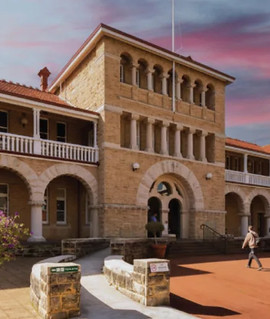 The cashless revolution has taken over many parts of Australia and it's even hit The Perth Mint. The tourist attraction in Western Australia allows you to buy collector coins, gold, silver and platinum bullion bars, jewellery and other items.
The cashless revolution has taken over many parts of Australia and it's even hit The Perth Mint. The tourist attraction in Western Australia allows you to buy collector coins, gold, silver and platinum bullion bars, jewellery and other items.
It's slightly different to the Royal Australian Mint in Canberra, which is responsible for producing the nation's change. But The Perth Mint is a hotspot for tourists and avid collectors, and it's not uncommon for crowds to line up outside when rare coins are released to get their hands on the collectables, which can skyrocket in value.
Adelaide resident Chris was one of these tourists, who recently went to the Perth Mint with a friend to buy a collectable coin and was "disappointed" when she was told an Australian location that makes collectible money, won't accept physical currency.
The Perth Mint is Australia's "largest fully integrated, innovative precious metals enterprise" and provides gold, silver and platinum products and services to markets across the world.
It's run by the Western Australian government and is the world's only government-owned and guaranteed precious metals enterprise.
A spokesperson for The Perth Mint told Yahoo Finance the decision to go cashless was not new.
It made the switch in July 2021.
"The cashless payment policy is part of our systems and processes to combat money laundering and other financial crime," they said.
Granted, the Perth Mint doesn't manufacture circulating coinage, and bullion products do lend themselves to money laundering schemes. The Royal Australian Mint in Canberra does still accept cash. -Editor
To read the complete article, see:
'Astounding' revelation about Australian mint amid cashless push: 'This is crazy'
(https://au.finance.yahoo.com/news/embarrassing-revelation-about-australian-mint-amid-cashless-push-this-is-crazy-022858748.html)


